Achillea millefolium
Yarrow
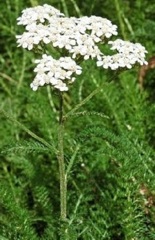
Yarrow was given it's name in honor of Achilles, a great hero of the Trojan war because he was reported to have used it regularly to heal himself from battle wounds. Having a long history of use, it has acquired many names, including Milfoil, Nosebleed, Soldiers Woundwort, Devil's Nettle and Bad Man's Plaything. While the first synonyms refer to it's incredible blood stanching abilities, the second two indicate it's association with witchcraft.
Invaluable to many as a first aid herb for it's astringent and tonic qualities, it was also prized as a great divination charm and was an ingredient in many love potions. When placed under the pillow it was supposed to bring dreams of one's future husband or wife if this verse was repeated:
"Oh pretty herb of Venus' tree,
Thy true name it is Yarrow;
Now who my bosom friend to be,
Pray tell thou me tomorrow."
Another name for it is Nosebleed, and inhaling a crushed leaf is often enough to stop a nosebleed or to, oddly, to start one. This also was often used to procure an omen, as shown in the poem "Yarroway, Yarroway, Bear a white blow, If you love love me my nose will bleed now!" Despite this quality Yarrow was at one time used as a snuff.
During the seventeenth century Yarrow remained very popular and at that point had been used in everything from demon exorcisms to salads.
Invaluable to many as a first aid herb for it's astringent and tonic qualities, it was also prized as a great divination charm and was an ingredient in many love potions. When placed under the pillow it was supposed to bring dreams of one's future husband or wife if this verse was repeated:
"Oh pretty herb of Venus' tree,
Thy true name it is Yarrow;
Now who my bosom friend to be,
Pray tell thou me tomorrow."
Another name for it is Nosebleed, and inhaling a crushed leaf is often enough to stop a nosebleed or to, oddly, to start one. This also was often used to procure an omen, as shown in the poem "Yarroway, Yarroway, Bear a white blow, If you love love me my nose will bleed now!" Despite this quality Yarrow was at one time used as a snuff.
During the seventeenth century Yarrow remained very popular and at that point had been used in everything from demon exorcisms to salads.
Aconitum
Monkshood
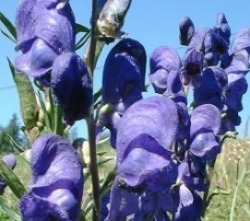
Beautiful and deadly, Monkshood is a favorite in perennial flower gardens, and its history as a medicine and a poison is nearly forgotten. The flowers are said to resemble the hooded head of a monk, and being quite striking they are still a common addition to many gardens.
Sometimes called Medea's Poison, it also carried the name Hecatais Herba, or Herb of Hecate. The plant is heavily associated with dark magic, and although it was used by physicians, being an effective painkiller and diaphoretic in tiny doses, the death toll of this flower certainly overshadows its use a medicine.
The earliest legend of Monkshood suggests that it was borne from the drool of Cerberus, the three-headed dog of Hades when he battled with Hercules. Often referred to as 'Wolfsbane' this plant was used to poison arrow tips which defended monks and townspeople from wolves. These poisoned arrows were known as elf bolts, and it is also said that poison was distributed at the watering holes of animals to keep the wolf count down.
There is also a recorded use of it in preventing men from changing into werewolves, and it was placed around the necks of suspicious men on full moons.
It is one of the ingredients in witch's flying ointment, which is not surprising for like many poisons, it can have a strongly sedating effect, and can be used to induce visions.
Sometimes called Medea's Poison, it also carried the name Hecatais Herba, or Herb of Hecate. The plant is heavily associated with dark magic, and although it was used by physicians, being an effective painkiller and diaphoretic in tiny doses, the death toll of this flower certainly overshadows its use a medicine.
The earliest legend of Monkshood suggests that it was borne from the drool of Cerberus, the three-headed dog of Hades when he battled with Hercules. Often referred to as 'Wolfsbane' this plant was used to poison arrow tips which defended monks and townspeople from wolves. These poisoned arrows were known as elf bolts, and it is also said that poison was distributed at the watering holes of animals to keep the wolf count down.
There is also a recorded use of it in preventing men from changing into werewolves, and it was placed around the necks of suspicious men on full moons.
It is one of the ingredients in witch's flying ointment, which is not surprising for like many poisons, it can have a strongly sedating effect, and can be used to induce visions.
Alcea rosea
Hollyhock
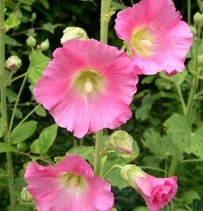
One of the most beautiful and celebrated plants of the English cottage garden, Hollyhock remains a popular feature in garden beds today.
Closely related to Marshmallow it is by far the more ornamental of the two species, though like Mallow it was frequently eaten and used as a pottage herb. Today it is considered unpalatable and strictly decorative.
Originally from China, Hollyhock was under cultivation in Europe in the early sixteen hundreds, where it was given the name "Holyoke" by the famous herbalist William Turner.
This plant was especially relished as a gargle for sore throats, tonsils and gums and was used regularly in remedies relating to loose teeth and mouth complaints. An infusion of the flowers was also used to treat coughs, and sometimes taken as a diuretic.
Amazingly, remains of the Hollyhock flower were found in a Neanderthal burial site, a cave in Shanidar Iraq.
Closely related to Marshmallow it is by far the more ornamental of the two species, though like Mallow it was frequently eaten and used as a pottage herb. Today it is considered unpalatable and strictly decorative.
Originally from China, Hollyhock was under cultivation in Europe in the early sixteen hundreds, where it was given the name "Holyoke" by the famous herbalist William Turner.
This plant was especially relished as a gargle for sore throats, tonsils and gums and was used regularly in remedies relating to loose teeth and mouth complaints. An infusion of the flowers was also used to treat coughs, and sometimes taken as a diuretic.
Amazingly, remains of the Hollyhock flower were found in a Neanderthal burial site, a cave in Shanidar Iraq.
Agrimonia eupatoria
Agrimony
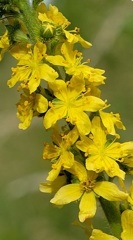
Once highly praised as an addition to tea because of it's delicate flavor, Agrimony has been regarded in herbalism since before the Roman civilization. It's name is from the ancient Greek 'Agremone' which was given to mean a plant which has healing properties for the eyes. During the middle ages it was regarded as the greatest of vulnerary herbs, and was the popular prescription for snake bites and any wound taken from a venomous beast. It's reputation evolved along the same lines over the course of centuries, for in the eighteen hundreds it was also thought to be a great curative for musket wounds.
Agrimony is a plant mentioned frequently in English folklore, primarily as a protection charm, and also as a sleep remedy. It was common practice to place a sprig under one's pillow to induce a deep sleep as recorded in the old English poem:
'If it be leyd under a mann's heed,
He shal sleepyn as he were deed;
He shal never drede ne wakyn
Til fro under his heed it be takyn.'
Agrimony is a plant mentioned frequently in English folklore, primarily as a protection charm, and also as a sleep remedy. It was common practice to place a sprig under one's pillow to induce a deep sleep as recorded in the old English poem:
'If it be leyd under a mann's heed,
He shal sleepyn as he were deed;
He shal never drede ne wakyn
Til fro under his heed it be takyn.'
Althaea officinalis
Mallow
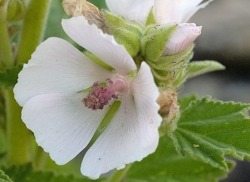
This herb has an ancient history as a food plant, and references date it to popular dishes all through the Roman empire and possibly ancient Egypt. It was eaten, though not praised, as a food staple in Syria, Greece and China. By the fourteenth century a dish of boiled mallow with onions and butter was apparently a common sight, and it was considered invaluable to both the kitchen and infirmary gardens.
Though seldom eaten today, it has maintained it's reputation as a helpful medicinal herb. The origin of it's name, Althaea comes from the Greek word altho meaning to cure, and suggesting it's deep rooted history as a physician's plant. It was used for all sorts of inflammations and applied as a salve or poultice to any tumor, swelling or roughening of skin. The roots were boiled in wine and prescribed for both coughs and menstrual cramps. Mallow is known for it's softening qualities, which one can easily intuit when looking at the delicate meadow bloom. Several varieties of Mallow are still grown for their ornamental flowers, and Marsh Mallow is cultivated on a small scale by modern herbalists.
Though seldom eaten today, it has maintained it's reputation as a helpful medicinal herb. The origin of it's name, Althaea comes from the Greek word altho meaning to cure, and suggesting it's deep rooted history as a physician's plant. It was used for all sorts of inflammations and applied as a salve or poultice to any tumor, swelling or roughening of skin. The roots were boiled in wine and prescribed for both coughs and menstrual cramps. Mallow is known for it's softening qualities, which one can easily intuit when looking at the delicate meadow bloom. Several varieties of Mallow are still grown for their ornamental flowers, and Marsh Mallow is cultivated on a small scale by modern herbalists.
Anemone pulsatilla
Pasqueflower
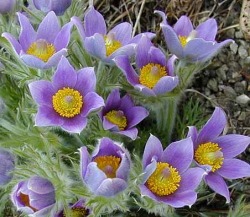
The name Anemone comes from the Greek word for wind anemos, giving the beautiful "Wind Flower" its name, the blossoms of which are said to open only in the wind. Anemone was the name of a nymph who attracted the love of Zephyr, the god of the west wind. Flora, who was the goddess of flowers became jealous, changing Anemone into the wind flower. Zephyr then abandoned her to Boreas, the god of the North wind, who Anemone did not desire. It is said of Anemone that her hopes and feelings are so easily aroused that she blooms earlier than other flowers, and always during a strong wind, then quickly fades and dies back.
Pasque Flower has sedative properties, and can be used as an antispasmodic and nerve tonic. It also has a long history of use as a painkiller.
Being a beautiful and unique looking flower, almost crocus-like in appearance but with a fuzzy foliage, pasque flower is grown abundantly and is one of the first blossoms of Spring.
Pasque Flower has sedative properties, and can be used as an antispasmodic and nerve tonic. It also has a long history of use as a painkiller.
Being a beautiful and unique looking flower, almost crocus-like in appearance but with a fuzzy foliage, pasque flower is grown abundantly and is one of the first blossoms of Spring.
Angelica archangelica
Angelica
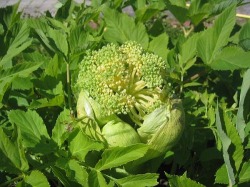
Possibly the most highly praised plant of the 14th century monks, the name itself implies its deep religious connotations. A common legend tells us that this plant was revealed in dreams by an angel to a Byzantine monk. Another tale suggests it acquired it's name because it blooms on May 8th, the day of Michael the archangel.
Whatever the origin, is strongly associated with the festival of the annunciation. Believed to be a powerful cure for the plague, Angelica was thought to have properties valuable in the case of any possible malady.
During the deeply superstitious years of the crusades, Angelica was used to protect one from evil, black magic and all manner of enchantments.
It has also been referred to as "The Root of the Holy Ghost" and a body wash was made from it's leaves to protect a person from ghosts and spirits.
Angelica is a primary ingredient in many modern herbal remedies for women, and is grown industrially for both western herbalism and traditional Chinese medicine, though it is marketed under the name Dong quai. It is also used extensively as a flavoring for cakes.
Whatever the origin, is strongly associated with the festival of the annunciation. Believed to be a powerful cure for the plague, Angelica was thought to have properties valuable in the case of any possible malady.
During the deeply superstitious years of the crusades, Angelica was used to protect one from evil, black magic and all manner of enchantments.
It has also been referred to as "The Root of the Holy Ghost" and a body wash was made from it's leaves to protect a person from ghosts and spirits.
Angelica is a primary ingredient in many modern herbal remedies for women, and is grown industrially for both western herbalism and traditional Chinese medicine, though it is marketed under the name Dong quai. It is also used extensively as a flavoring for cakes.
Anthemis nobilis
Chamomile
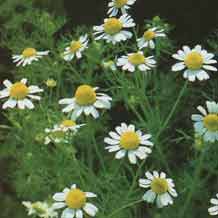
This gentle but vigorous groundcover has throughout the ages maintained it's popularity in the garden, the apothecary and the teacup. It's use as a nervine tonic has rendered it invaluable to both the natural health and tea industry, but it's traditional uses have included everything from a wound wash to a cure for bad luck. It was a common remedy for fever, hysteria or any stomach complaints.
Known throughout the monasteries as "the plant's physician" it was believed that any garden bed containing Chamomile would flourish as it would act as a tonic for the other plants. Consequently it was grown in every garden, and was also a groundcover for paths. It was esteemed as a strewing herb, and was sprinkled over the stone floors to release it's pleasant smell.
It has long been attributed with a supernatural ability to attract money, and was considered a friend to all gamblers. A hand wash of chamomile was often used to increase luck in games of cards, which were becoming very popular by the fifteenth century.
Known throughout the monasteries as "the plant's physician" it was believed that any garden bed containing Chamomile would flourish as it would act as a tonic for the other plants. Consequently it was grown in every garden, and was also a groundcover for paths. It was esteemed as a strewing herb, and was sprinkled over the stone floors to release it's pleasant smell.
It has long been attributed with a supernatural ability to attract money, and was considered a friend to all gamblers. A hand wash of chamomile was often used to increase luck in games of cards, which were becoming very popular by the fifteenth century.
Arnica montana
Arnica
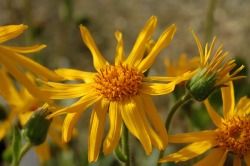
Still used regularly today to treat bruises and wounds, it was used during the Medieval period for the same purpose. The ancient German people called this the "Wolf Flower" and it was used in an elaborate yearly ritual involving the grain harvest. People believed that a spirit referred to as the Corn Wolf was responsible for lending his strength to the harvest, and Arnica was grown around the fields to prevent him from leaving before the grain was ripe.
Interestingly, Arnica chamissonis (which is the American relative of European Arnica) was held in similar esteem by the North American indigenous communities, and was also used to treat wounds.
Interestingly, Arnica chamissonis (which is the American relative of European Arnica) was held in similar esteem by the North American indigenous communities, and was also used to treat wounds.
Artemisia abrotanum
Southernwood

Not frequently used today for it's culinary purposes, it was once a favorite for herbal vinegars and was often used in the preparation of meats. It is a relative of Wormwood, and has a similarly pungent aroma, making it an excellent insect repellent. A common moth repellent called for Southernwood, Lavender and Roses, crushed together and cured in a crock pot. As the matter of fact, the French referred to it as 'Garden Robe' for it's effectiveness as a moth repellent.
Other historical names for the plant however, suggest it's other uses. The nicknames 'Lad's Love' and 'Maids Ruin' refer to it's alleged properties as an aphrodisiac and it's power to increase a man's virility. Young men were said to rub their faces with it to hurry the growth of a beard, and even dating back to Rome men carried it as protection against impotence. It was employed in love magic, and slipped under mattresses to rouse lust in their sleeping occupants. Sprays of it's silvery foliage were often included in bouquets to highlight the intention to seduce.
Apparently it was often carried into church, for it was believed that the sharp, bitter smell of the plant would keep one from dozing off during the service.
Other historical names for the plant however, suggest it's other uses. The nicknames 'Lad's Love' and 'Maids Ruin' refer to it's alleged properties as an aphrodisiac and it's power to increase a man's virility. Young men were said to rub their faces with it to hurry the growth of a beard, and even dating back to Rome men carried it as protection against impotence. It was employed in love magic, and slipped under mattresses to rouse lust in their sleeping occupants. Sprays of it's silvery foliage were often included in bouquets to highlight the intention to seduce.
Apparently it was often carried into church, for it was believed that the sharp, bitter smell of the plant would keep one from dozing off during the service.
Artemisia absinthium
Wormwood
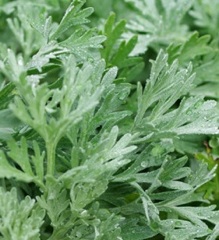
With the exception of rue, Wormwood was the bitterest herb used during the Medieval period, and it's ability to resist putrefaction made it invaluable as an antiseptic. It received it's name in Hellenistic culture, where it was associated with Artemis, Goddess of the hunt and protector of forests and children.
It has a long history as a vermifuge, and was a favored treatment for intestinal worms and all manner of parasites. Believed to counteract the effects of many poisons, it was also used to expel venom from snake bites, and purge the system of hemlock and toadstools.
Despite the bitter nature of the plant, it is mentioned frequently in recipes for love charms, and as a protection amulet. Wormwood was also used as an incense of which the smoke was said to chase away demons and unwanted spirits. It also appears on lists of ancient divinitory herbs and was said to increase psychic abilities. This might in part be attributed to the fact that Wormwood is known today for having a mild psychoactive effect, and is famed as an ingredient in the notorious liquor Absinthe.
Whatever the reason for it's immense popularity it has certainly lasted as both a medicinal and garden plant. An old rhyme refers to it lovingly:
'What saver is better if physick be true
For places infected than wormwood and rue?
It is a comfort for hart and the braine
And therefore to have it it is not in vaine.'
It has a long history as a vermifuge, and was a favored treatment for intestinal worms and all manner of parasites. Believed to counteract the effects of many poisons, it was also used to expel venom from snake bites, and purge the system of hemlock and toadstools.
Despite the bitter nature of the plant, it is mentioned frequently in recipes for love charms, and as a protection amulet. Wormwood was also used as an incense of which the smoke was said to chase away demons and unwanted spirits. It also appears on lists of ancient divinitory herbs and was said to increase psychic abilities. This might in part be attributed to the fact that Wormwood is known today for having a mild psychoactive effect, and is famed as an ingredient in the notorious liquor Absinthe.
Whatever the reason for it's immense popularity it has certainly lasted as both a medicinal and garden plant. An old rhyme refers to it lovingly:
'What saver is better if physick be true
For places infected than wormwood and rue?
It is a comfort for hart and the braine
And therefore to have it it is not in vaine.'
Artemisia vulgaris
Mugwort

It has been disputed whether 'mug' refers to the drinking cup or moughte, meaning moth, for this plant has been equally praised as a brewing herb and a moth repellent.
Some of the oldest writing found on Mugwort, which dates back to ancient Rome, describes it as plant for travelers. It was thought not only to cure weariness, but also to protect one from the attacks of both wild beasts and dark spirits. Roman soldiers were known to have placed sprigs of it in their shoes claiming that it stopped their feet from aching. I don't doubt it's antibacterial properties were appreciated as well.
William Coles, in 1656 wrote of Mugwort "If a footman put it into his shoes in the morning he may go forty miles before noon and not be weary."
During the Middle Ages, the herb was named Cingulum Sancti Johannis for John the Baptist was said to have worn a girdle of it in the wilderness. On St. Johns Eve, wreathes were made from Mugwort and worn to ensure safety from demonic possession. Indeed it was attributed with endless magical properties including warding off the plague and bad dreams. Sprigs were not uncommonly discovered under the pillows of troubled sleepers.
Mugwort is an invaluable herb in natural medicine today and is still grown in abundance.
Some of the oldest writing found on Mugwort, which dates back to ancient Rome, describes it as plant for travelers. It was thought not only to cure weariness, but also to protect one from the attacks of both wild beasts and dark spirits. Roman soldiers were known to have placed sprigs of it in their shoes claiming that it stopped their feet from aching. I don't doubt it's antibacterial properties were appreciated as well.
William Coles, in 1656 wrote of Mugwort "If a footman put it into his shoes in the morning he may go forty miles before noon and not be weary."
During the Middle Ages, the herb was named Cingulum Sancti Johannis for John the Baptist was said to have worn a girdle of it in the wilderness. On St. Johns Eve, wreathes were made from Mugwort and worn to ensure safety from demonic possession. Indeed it was attributed with endless magical properties including warding off the plague and bad dreams. Sprigs were not uncommonly discovered under the pillows of troubled sleepers.
Mugwort is an invaluable herb in natural medicine today and is still grown in abundance.
Atropa belladonna
Belladonna
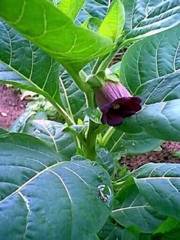
It's reputation for death by poison precedes this plant, and it is still known largely by it's common name Deadly Nightshade. The name Atropa refers to one of the mythological Fates; Atropus was picutered as holding a pair of shears in her hand, and snipping the threads of human lives. Belladonna is Italian for 'beautiful woman,' and it refers to the practice of placing eye drops, which were a decoction of atropa into ones eyes. This dilated the pupils which was believed to make a woman more desirable.
This attractive woodland plant, which is in fact a relative of the potato, has been named as the weapon in several historical accounts of mass murder, the most famous of which is the poisoning of Marc Antony's troops during the Parthian war. Despite this legend, Roman priests were said to drink it's juice regularly when they worshiped Bellona, the Goddess of War. Another notorious case is related in A History of Scotland (Buchanan, 1582) and claims that during the tenth century the Scots poisoned an entire invading army of Danes with a liquor infused with Belladonna, putting the Danes into a deep trance and leaving them defenseless and under attack.
The plant is heavily associated with the Devil, who was said to delight in it and to wander the gardens collecting it's fruit in the night. The red fruit was likened to the apples of Sodom, nicknamed Devil's Cherries, and it was even rumored that the plant itself had the power to adopt the form of an enchantress who was so beautiful it was dangerous even to look at her.
Belladonna is listed as being one of the irreplaceable ingredients in witch's flying ointment, but it's intoxicating and sedative properties were often harnessed for medical purposes as well. A potion of it's leaves was ingested before a patient underwent any form of surgery or cauterization.
Belladonna is becoming a rare sight in today's garden. Although many popular flowers and bedding plants are equally as poisonous, its dark reputation seems to have banished it from the perennial flower beds and the tables of local nurseries.
This attractive woodland plant, which is in fact a relative of the potato, has been named as the weapon in several historical accounts of mass murder, the most famous of which is the poisoning of Marc Antony's troops during the Parthian war. Despite this legend, Roman priests were said to drink it's juice regularly when they worshiped Bellona, the Goddess of War. Another notorious case is related in A History of Scotland (Buchanan, 1582) and claims that during the tenth century the Scots poisoned an entire invading army of Danes with a liquor infused with Belladonna, putting the Danes into a deep trance and leaving them defenseless and under attack.
The plant is heavily associated with the Devil, who was said to delight in it and to wander the gardens collecting it's fruit in the night. The red fruit was likened to the apples of Sodom, nicknamed Devil's Cherries, and it was even rumored that the plant itself had the power to adopt the form of an enchantress who was so beautiful it was dangerous even to look at her.
Belladonna is listed as being one of the irreplaceable ingredients in witch's flying ointment, but it's intoxicating and sedative properties were often harnessed for medical purposes as well. A potion of it's leaves was ingested before a patient underwent any form of surgery or cauterization.
Belladonna is becoming a rare sight in today's garden. Although many popular flowers and bedding plants are equally as poisonous, its dark reputation seems to have banished it from the perennial flower beds and the tables of local nurseries.
Aquilegia vulgaris
Columbine
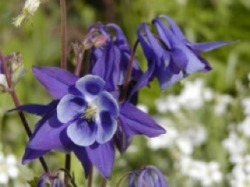
Still heavily cultivated for it's beautiful flower, Columbine is a woodland and meadow plant native to northern Europe.
The Latin for this comes from the word 'aquila' meaning eagle, and the common name from the word 'columba' meaning dove or pigeon. Apparently people likened the blossom to a crowd of birds nestling together. At one time Columbine was also referred to as 'lion's herb' because it was believed to be a favorite of those huge felines. In the tradition of folklore, people then ascribed the herb itself with the powers of a lion, claiming it brought great courage and that even washing one's hands in it's nectar would render one fearless.
The leaves of columbine were employed by physicians to treat sore mouths and throats, and were often made into lotions and salves. Taken in wine, the seed was thought to be helpful in childbirth.
The Latin for this comes from the word 'aquila' meaning eagle, and the common name from the word 'columba' meaning dove or pigeon. Apparently people likened the blossom to a crowd of birds nestling together. At one time Columbine was also referred to as 'lion's herb' because it was believed to be a favorite of those huge felines. In the tradition of folklore, people then ascribed the herb itself with the powers of a lion, claiming it brought great courage and that even washing one's hands in it's nectar would render one fearless.
The leaves of columbine were employed by physicians to treat sore mouths and throats, and were often made into lotions and salves. Taken in wine, the seed was thought to be helpful in childbirth.
Convallaria majalis
Lily of the Valley
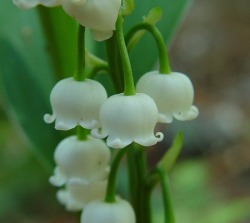
The Bible and accounts of the saints are riddled with references to this fragrant and beautiful plant, which consequently was grown and highly praised in monastic gardens. They are mentioned poetically in the Song of Solomon: "Consider the lilies of the field, how they grow; they toil not, neither do they spin; and yet i say unto you, That even Solomon in all his glory was not arrayed like one of these."
It has earned itself several names of a religious nature, including Ladder to Heaven and Jacob's Tears. There is even a legend that lily of the valley sprouted from the tears Mary is said to have shed at Christ's execution. Outside of it's religious context, the plant is also known as May Lily and Fairy Bells and was one of the cherished decorations of the Beltaine or Mayday festival.
Lily of the Valley was thought to be an excellent memory aid, and soaking the head in its juices was said to restore common sense. A "miraculous" liquid known as Golden Water was actually a distillation of this plant and was reported to lend new vigor to tired, aged limbs, restore speech to the dumb and comfort the heart.
If one looks closely at tapestries from the Medieval Ages, one can see this indomitable and charming plant was an adored subject for many artists.
It has earned itself several names of a religious nature, including Ladder to Heaven and Jacob's Tears. There is even a legend that lily of the valley sprouted from the tears Mary is said to have shed at Christ's execution. Outside of it's religious context, the plant is also known as May Lily and Fairy Bells and was one of the cherished decorations of the Beltaine or Mayday festival.
Lily of the Valley was thought to be an excellent memory aid, and soaking the head in its juices was said to restore common sense. A "miraculous" liquid known as Golden Water was actually a distillation of this plant and was reported to lend new vigor to tired, aged limbs, restore speech to the dumb and comfort the heart.
If one looks closely at tapestries from the Medieval Ages, one can see this indomitable and charming plant was an adored subject for many artists.
Cichorium intybus
Chicory
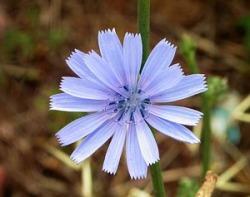
Also known as Succory, it was an invaluable perennial food plant. While the broad and bitter leaves were relied upon in Rome as a salad green, the roasted roots became very popular as a coffee-like beverage and the plant was also used for animal fodder.
Succory was praised for it's medicinal virtues and was often prescribed to children for stomach complaints or as a laxative. It was believed to help with jaundice and complaints relating to the gall, spleen and liver.
There are many folktales linking Succory to the plight of an abandoned lover. One legend tells us that the flower obtained it's startling blue color from the teary eyes of a maiden looking out to sea, waiting for her lovers ship. Another old tale tells of a girl waiting in the road for a love who never returned, until finally she died of heartbreak and was transformed into the beautiful Succory plant. Similarly a story tells us of how one maiden was so distressed when her lover went off to sea that the Gods, pitying her, turned her into this blue flower. These stories have bestowed upon it the name Blue Sailor Weed and Watcher of the Road.
Succory was praised for it's medicinal virtues and was often prescribed to children for stomach complaints or as a laxative. It was believed to help with jaundice and complaints relating to the gall, spleen and liver.
There are many folktales linking Succory to the plight of an abandoned lover. One legend tells us that the flower obtained it's startling blue color from the teary eyes of a maiden looking out to sea, waiting for her lovers ship. Another old tale tells of a girl waiting in the road for a love who never returned, until finally she died of heartbreak and was transformed into the beautiful Succory plant. Similarly a story tells us of how one maiden was so distressed when her lover went off to sea that the Gods, pitying her, turned her into this blue flower. These stories have bestowed upon it the name Blue Sailor Weed and Watcher of the Road.
Cnicus benedictus
Blessed Thistle
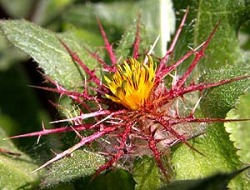
Blessed Thistle was heavily cultivated in the monasteries of 15th century Europe, who attributed it with incredible healing properties. It was used to treat both the plague and small pox, and being considered a general tonic it was taken regularly to prevent ailments and stimulate the apatite.
Shakespeare praises the herb in Much Ado About Nothing:
'Get you some of this Carduus Benetictus and lay it to your heart; it is the only thing for your qualm...I mean plain Holy Thistle...Therefore I counsell all that have gardens to nourish it, that they may have it always to their own use, and the use of their neighbors that lacke it."
Despite the abundance of history surrounding it and the advice of Shakespeare, Cnicus benedictus is rarely seen in today's garden and when it is, it is often in the form of a weed.
Shakespeare praises the herb in Much Ado About Nothing:
'Get you some of this Carduus Benetictus and lay it to your heart; it is the only thing for your qualm...I mean plain Holy Thistle...Therefore I counsell all that have gardens to nourish it, that they may have it always to their own use, and the use of their neighbors that lacke it."
Despite the abundance of history surrounding it and the advice of Shakespeare, Cnicus benedictus is rarely seen in today's garden and when it is, it is often in the form of a weed.
Crocus sativus
Saffron
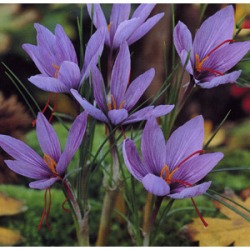
Saffron, which is the stigma of lovely, large-flowered crocus, grows wild throughout Europe. Despite it's availability, it remains both a great commodity and a great expense, in fact it is the worlds most valuable spice. On average it takes approximately sixty-thousand of these stigmas to produce one pound, not to mention the labor that is required to hand gather them.
Saffron was used to treat smallpox, as well as a number of heart and lung conditions, and was said to refresh the spirit.
Legend states that during the fourteenth century a monk returned from a pilgrimage to the Holy Land, smuggling a bulb back in the hollow of his staff, and cultivating it to bring prosperity to the town.
It has been listed as an aphrodisiac and several writers refer to it's ability to induce laughing fits.
Culpepper, in 1649 writes "Some have fallen into an immoderate convulsive laughter which ended in death."
Francis Bacon writes simply "It maketh the English sprightly."
Saffron was used to treat smallpox, as well as a number of heart and lung conditions, and was said to refresh the spirit.
Legend states that during the fourteenth century a monk returned from a pilgrimage to the Holy Land, smuggling a bulb back in the hollow of his staff, and cultivating it to bring prosperity to the town.
It has been listed as an aphrodisiac and several writers refer to it's ability to induce laughing fits.
Culpepper, in 1649 writes "Some have fallen into an immoderate convulsive laughter which ended in death."
Francis Bacon writes simply "It maketh the English sprightly."
Cynara cardunculus
Cardoon
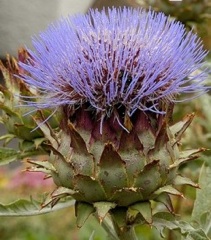
Though it would seem that artichokes have supplanted Cardoon on most dinner tables, this 'globe artichoke' was at one point a common meal. The flower heads are enjoyed much the same way as artichoke flowers, while the stems sauteed in butter were also a regular meal. In Rome the stalks were eaten raw dipped in olive oil.
Cardoon was a popular dish in ancient Greece as well as Rome, and by the twelfth century it was a staple food crop all throughout Europe. It was particularly popular with the Spanish, and stories tell us that when they arrived in droves to colonize the "New World" they brought their favorite breed of cow and their Cardoon plants with them. Unfortunately both were to revert completely, the Cardoon becoming again little more than a wild thistle, and the cattle going bony and feral in the mountains.
Cardoon a very striking plant with its sharp-toothed silver leaves and its enormous flower head, and seems to be cultivated more as an attractive border plant than as supper.
Cardoon was a popular dish in ancient Greece as well as Rome, and by the twelfth century it was a staple food crop all throughout Europe. It was particularly popular with the Spanish, and stories tell us that when they arrived in droves to colonize the "New World" they brought their favorite breed of cow and their Cardoon plants with them. Unfortunately both were to revert completely, the Cardoon becoming again little more than a wild thistle, and the cattle going bony and feral in the mountains.
Cardoon a very striking plant with its sharp-toothed silver leaves and its enormous flower head, and seems to be cultivated more as an attractive border plant than as supper.
Digitalis purpurea
Foxglove

Historically, this woodland flower has been intrinsically linked to the faerie kingdom. It's name was originally "Folk's Glove," being the glove of the "good folk" or faeries. Later, a story tells of how malicious sprites lent the purple blossoms to foxes, to give their paws soft padding and so make their attack silent. An alternate version tells us that faeries taught foxes the secret of ringing the bells to warn each other of hunters, thus saving them from extinction. Their speckled blooms were said to be evidence of where elves had placed their tiny fingers.
In Ireland it was referred to as "Dead Man's Thimbles," for Digitalis is extremely poisonous. Despite it's toxicity, the juices of this plant were employed by ancient physicians to an extent that horrifies today's herbalists. It was used as poultice and wound wash for sores and ulcers, and frequently taken internally in rather dangerous quantities as a heart medicine.
Because the little people were known to have loved these plants so much, it was considered ill luck to bring them inside as a cut flower, although the juice was sometimes smeared on children to ward off kidnappers. Child theft was anciently attributed to faeries.
In Ireland it was referred to as "Dead Man's Thimbles," for Digitalis is extremely poisonous. Despite it's toxicity, the juices of this plant were employed by ancient physicians to an extent that horrifies today's herbalists. It was used as poultice and wound wash for sores and ulcers, and frequently taken internally in rather dangerous quantities as a heart medicine.
Because the little people were known to have loved these plants so much, it was considered ill luck to bring them inside as a cut flower, although the juice was sometimes smeared on children to ward off kidnappers. Child theft was anciently attributed to faeries.
Foeniculum vulgare
Fennel
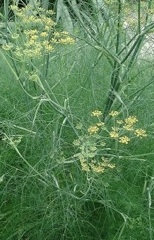
A delicious licorice flavored plant with soft fern-like foliage, Fennel was a favorite herb of the early Romans. It was cultivated there as a food plant, the young shoots being an ingredient in many old dishes, but it also had an esteemed reputation in medicine. They ascribed it incredible powers of healing eyesight, and it was highly recommended that the juices be rubbed over ones eyes to preserve vision. The soldiers were also said to chew it before battle to lend them courage and strength on the field.
Fennel seeds were considered a symbol of fertility, and farmers in England supposedly rubbed a mixture of Fennel, soap and salt on the blades of their plows, believing it would strengthen the land and increase harvest yields. It was also thrown on newly married couples instead of rice.
On Midsummer's Eve this plant was often hung over the doorway to repel spirits from one's house, and seeds popped into keyholes to prevent ghosts from entering. It has long been attributed with protective qualities.
Still used in modern medicine as an excellent digestive aid, and seeds are served as an after dinner snack in many homes and restaurants for this purpose.
Fennel seeds were considered a symbol of fertility, and farmers in England supposedly rubbed a mixture of Fennel, soap and salt on the blades of their plows, believing it would strengthen the land and increase harvest yields. It was also thrown on newly married couples instead of rice.
On Midsummer's Eve this plant was often hung over the doorway to repel spirits from one's house, and seeds popped into keyholes to prevent ghosts from entering. It has long been attributed with protective qualities.
Still used in modern medicine as an excellent digestive aid, and seeds are served as an after dinner snack in many homes and restaurants for this purpose.
Galium verum
Lady's Bedstraw
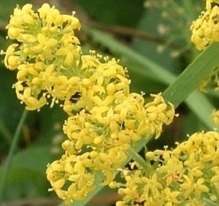
The name Lady's Bedstraw can be applied quite literally to this plant, as it was used to stuff mattresses. In times when the common folk were lying on beds of straw, the upper classes were sleeping on beds of sweetly scented herbs, and the fresh, hay-like scent of this plant combined with it's flea repelling qualities made it a favorite.
It has also been called by the title "Cheese Rennet" for it's ability to curdle milk. It was a necessary ingredient to all dairy farms, and was thought to lend a sweet flavor to the cheeses. Being a dye plant as well, it also turned the dairy products a desirable gold color.
There is some suggestion that is was used by women as a hair rinse to bring out the yellow in their hair, especially during the sixteenth century where golden tresses were becoming so prized. This is implied plainly in another name for the plant "Maid's Hair."
It has also been called by the title "Cheese Rennet" for it's ability to curdle milk. It was a necessary ingredient to all dairy farms, and was thought to lend a sweet flavor to the cheeses. Being a dye plant as well, it also turned the dairy products a desirable gold color.
There is some suggestion that is was used by women as a hair rinse to bring out the yellow in their hair, especially during the sixteenth century where golden tresses were becoming so prized. This is implied plainly in another name for the plant "Maid's Hair."
Helleborus niger
Black Hellebore
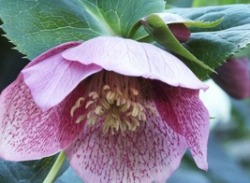
Its dark history has not dissuaded gardeners from their love of this woodland plant. It's a very popular shade flower, blooming often around January, and to some it represents hope that the winter will soon break.
Helleborus is indisputably poisonous, it's very name, derived from elein and bora meaning food and to injure. Nevertheless, it was a well used medicine in ancient times, and was believed to cure insanity. In legend it was the plant used to cure the daughters of King Midas, who were struck with madness and found running naked through the streets.
Although it was used by Greek physicians to treat mental disorders, paralysis and gout, they also employed it as a weapon against their enemies. In one case, during the Siege of Kirrha they used Helleborus leaves to poison the water supply, and as the inhabitants suffered from diarrhea they were able to win the city. This charming plant was also the death of Alexander the Great.
Hellebore is equally associated with dark witchcraft and Christianity. It is said to be used to conjure demons, yet is referred to as the Christ Herbe for its beautiful buds which often bloom on Christmas.
Helleborus is indisputably poisonous, it's very name, derived from elein and bora meaning food and to injure. Nevertheless, it was a well used medicine in ancient times, and was believed to cure insanity. In legend it was the plant used to cure the daughters of King Midas, who were struck with madness and found running naked through the streets.
Although it was used by Greek physicians to treat mental disorders, paralysis and gout, they also employed it as a weapon against their enemies. In one case, during the Siege of Kirrha they used Helleborus leaves to poison the water supply, and as the inhabitants suffered from diarrhea they were able to win the city. This charming plant was also the death of Alexander the Great.
Hellebore is equally associated with dark witchcraft and Christianity. It is said to be used to conjure demons, yet is referred to as the Christ Herbe for its beautiful buds which often bloom on Christmas.
Hypericum perforatum
St. John's wort
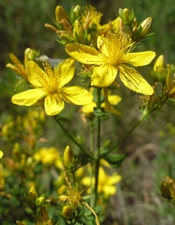
The tenacious gold flowers of St. John's wort were anciently associated with the sun. While this herb may have earned its biblical name in around the 6th century, it's use as a sacred plant far predates the Christian religion. It was recorded as a much used plant in Greek medical texts dating back to 288 B.C. and was also a respected plant among the Celts and early Germanic peoples.
Much of the history surrounding it revolves around its use as a divination plant. Like Yarrow it was used in all manner of love charms, and inspired poems such as "Thou silver glow worm, lend me thy light, I must gather the mystic St. John's Wort tonight; This wonderful herb whose leaf will decide, if the coming year will see me a bride."
It was also thought to have a protective influence on the home, and was often brought as a gift to one's house at midsummer's eve to protect from spirits and hexes. Another old poem refers to this: "St. John's Wort doth charm all the witches away, If gathered at midnight on the saint's holy day. And devil's and witches have no power to harm Those that do gather the plant for a charm."
Much of the history surrounding it revolves around its use as a divination plant. Like Yarrow it was used in all manner of love charms, and inspired poems such as "Thou silver glow worm, lend me thy light, I must gather the mystic St. John's Wort tonight; This wonderful herb whose leaf will decide, if the coming year will see me a bride."
It was also thought to have a protective influence on the home, and was often brought as a gift to one's house at midsummer's eve to protect from spirits and hexes. Another old poem refers to this: "St. John's Wort doth charm all the witches away, If gathered at midnight on the saint's holy day. And devil's and witches have no power to harm Those that do gather the plant for a charm."
Levisticum officinale
Lovage
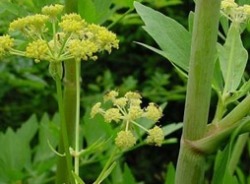
Although not as common a garden plant as it once was, Lovage is still used for it for culinary and medicinal purposes. To the untrained eye, it may be mistaken for celery, and it's intense aroma is also very reminiscent of it's vegetable cousin. However, it has a far stronger flavor, and as it is a powerful diuretic it's recommended to use a much smaller amount of it.
It was much used as a medicine during the fourteen hundreds, and was used, among other things for rheumatism, jaundice and colic. Fresh juice squeezed onto the eye was thought to be a cure for pink eye, and practitioners boasted that the seeds themselves could cure freckles!
It was a custom for young maidens to wear small pouches of Lovage around their necks to attract appropriate suitors, and Lovage has long been associated with love magic.
Levisticum is used in Traditional Chinese Medicine.
It was much used as a medicine during the fourteen hundreds, and was used, among other things for rheumatism, jaundice and colic. Fresh juice squeezed onto the eye was thought to be a cure for pink eye, and practitioners boasted that the seeds themselves could cure freckles!
It was a custom for young maidens to wear small pouches of Lovage around their necks to attract appropriate suitors, and Lovage has long been associated with love magic.
Levisticum is used in Traditional Chinese Medicine.
Galium odoratum
Sweet Woodruff
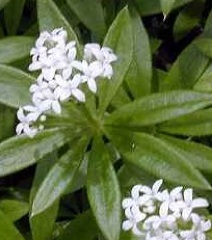
This shade loving groundcover was very important during the Medieval period. When cut the leaves have a delicate, almost hay-like smell, and consequently it was popular as both a strewing herb and mattress stuffing. People found the scent very soothing, and believed it to have a cooling, purifying effect on the air. It was commonly hung in churches, and on certain celebrations huge bunches of Woodruff, Lavender and Roses were to be found there. It could be accounted a sort of herbal air freshener, for it was hung all about peoples home to cool and sweeten the air.
Sweet Woodruff plays an invaluable role in the Beltaine ceremonies, being the main ingredient in the maibowle, which is white wine steeped strongly in its leaves. This drink can still be found in parts of Germany, although the plant is now considered slightly toxic and it's recommended to use only a few sprigs in the preparation.
It was, in the days of it's popularity as a medicinal plant, said to be beneficial to drink a cordial of Woodruff on a regular basis, and it was thought to be excellent when applied to cuts and wounds.
Sweet Woodruff is a beautiful plant, and one may recognize it as the lush understory in many shade gardens.
Sweet Woodruff plays an invaluable role in the Beltaine ceremonies, being the main ingredient in the maibowle, which is white wine steeped strongly in its leaves. This drink can still be found in parts of Germany, although the plant is now considered slightly toxic and it's recommended to use only a few sprigs in the preparation.
It was, in the days of it's popularity as a medicinal plant, said to be beneficial to drink a cordial of Woodruff on a regular basis, and it was thought to be excellent when applied to cuts and wounds.
Sweet Woodruff is a beautiful plant, and one may recognize it as the lush understory in many shade gardens.
Glycyrrhiza glabra
Liquorice
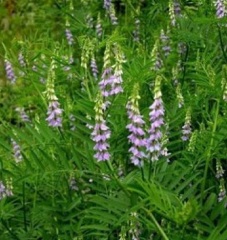
Licorice needs little or no introduction, having grown steadily in use, popularity and cultivation from the twelfth century to now. It is recorded as having been introduced to England in the first year of Queen Elizabeth's reign, but it was grown and used abundantly in Germany, Italy, Spain and many other parts of Europe for centuries prior. It was used as an extract in as early as the eleven hundreds, and was a favorite treatment for bronchitis and respiratory disorders, being highly valued by apothecaries all through the Middle Ages. In truth, it was also a highly prized plant all through ancient Egypt as well, and large quantities of it were found in King Tut's tomb.
It has had an immense value as a sweetener, the roots being very high in glycyrrhizic acid, a compound actually sweeter than sugar. Of course licorice candy is well known to us all, and has been in production since the seventeenth century. Seemingly the candy itself originated in Holland, but even the ancient Greeks recognized its qualities in their name for it "Sweet Root."
This bushy legume relative is not overly ornamental and rarely seen in home gardens, but is irreplacable as a medicinal and useful plant. Licorice is still cultivated on an industrial level.
It has had an immense value as a sweetener, the roots being very high in glycyrrhizic acid, a compound actually sweeter than sugar. Of course licorice candy is well known to us all, and has been in production since the seventeenth century. Seemingly the candy itself originated in Holland, but even the ancient Greeks recognized its qualities in their name for it "Sweet Root."
This bushy legume relative is not overly ornamental and rarely seen in home gardens, but is irreplacable as a medicinal and useful plant. Licorice is still cultivated on an industrial level.
Hyoscyamus niger
Henbane
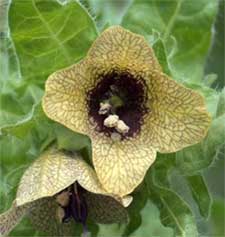
It would be hard to find a more infamously magical plant than Henbane. Alongside belladonna it is another ingredient in the famous flying potions, and it has an ancient association with witchcraft, weather magic and of course poisonings. In Greek mythology for instance, the dead are said to be crowned with it when entering Hades.
What many do not realize, is how rich a history this plant has as a medicine. In as early as the first century it was used as a sleeping draught and painkiller, although it was related to be much like wine and as Pliny stated "offensive to the understanding." Certainly, being itself a strongly psychoactive plant, Henbane has been known to muddle the mind. A writer from the fourteenth century says of it "If it be used either in a sallet or pottage, then doth it bring frenzie, and whoso useth more than four leaves shall be in danger to sleep without waking." An old story tells us that once an entire monastery was poisoned by accidentally using the leaves of Henbane instead of chicory in a pottage. The whole establishment suffered days of incredible hallucinations and illness.
Following an ancient superstition that witches control the weather, Henbane was placed as a culprit in these acts of weather magic, and was said to be used to invoke storms. It is also associated with rituals to ease the dead into the otherworld.
Any lover of beer may be interested to know that Henbane was an ingredient in an ancient pilsner, and evidence of Henbane beer has been found in at least one Neolithic site in Scotland. It is rather unpopular if not illegal in this day and age, as getting too deep in the cups might render one alarmingly drugged and sedated.
What many do not realize, is how rich a history this plant has as a medicine. In as early as the first century it was used as a sleeping draught and painkiller, although it was related to be much like wine and as Pliny stated "offensive to the understanding." Certainly, being itself a strongly psychoactive plant, Henbane has been known to muddle the mind. A writer from the fourteenth century says of it "If it be used either in a sallet or pottage, then doth it bring frenzie, and whoso useth more than four leaves shall be in danger to sleep without waking." An old story tells us that once an entire monastery was poisoned by accidentally using the leaves of Henbane instead of chicory in a pottage. The whole establishment suffered days of incredible hallucinations and illness.
Following an ancient superstition that witches control the weather, Henbane was placed as a culprit in these acts of weather magic, and was said to be used to invoke storms. It is also associated with rituals to ease the dead into the otherworld.
Any lover of beer may be interested to know that Henbane was an ingredient in an ancient pilsner, and evidence of Henbane beer has been found in at least one Neolithic site in Scotland. It is rather unpopular if not illegal in this day and age, as getting too deep in the cups might render one alarmingly drugged and sedated.
Hyssopus officinalis
Hyssop
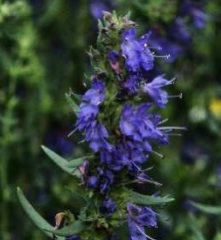
Hyssop has a long history of medicinal and spiritual use. It's name is taken from the Hebrew word azob meaning a holy herb. It is a plant mentioned several times in the Bible as an important herb of sacrifice and purification, most significantly in the New Testament where it is noted as the plant offered up to Jesus during the execution.
In Greece it was a favorite herb of the temples, being burned frequently to purify and sanctify spaces in a similar tradition to the Native American sage smudge.
In medicine it was applied topically to wounds and bruises, and also used to treat muscular rheumatism. A tea was made from it to offer relief from asthma, and being a very aromatic plant, the tea was also used simply as an enjoyable tonic.
A very ornamental border plant, similar in it's appearance and growth habit to Lavender, it has been used in gardens throughout the ages. It gained much favor during Tudor England, as it provided a perfectly complimentary shape and color for the knot gardens that were popular.
In Greece it was a favorite herb of the temples, being burned frequently to purify and sanctify spaces in a similar tradition to the Native American sage smudge.
In medicine it was applied topically to wounds and bruises, and also used to treat muscular rheumatism. A tea was made from it to offer relief from asthma, and being a very aromatic plant, the tea was also used simply as an enjoyable tonic.
A very ornamental border plant, similar in it's appearance and growth habit to Lavender, it has been used in gardens throughout the ages. It gained much favor during Tudor England, as it provided a perfectly complimentary shape and color for the knot gardens that were popular.
Inula helenium
Elecampane

The name Helenium is born from a legend connecting this plant to Helen of Troy, which is said to have sprung up from her tears. In Celtic countries, it was referred to as "Elfwort."
Elecampane was a favorite in ancient Rome both as a food plant and a medicinal herb. The Inula grows a large tuberous root, of quite a bitter flavor, but was enjoyed despite this. It was commonly pounded with Fennel to sweeten it and served as a dessert or digestive. It was still regularly seen in England as a candy up until the late nineteen hundreds.
It is the root that is used today in modern herbalism, it being a wonderful expectorant and tonic for the lungs, and it is used quite frequently in cough medicines. During it's introduction into Europe in the Medieval period, it was used to treat infections, chewed to "fasten the teeth," taken as a cordial and worn to protect one from poisonous insects and venomous beasts.
It has also been praised for it's qualities as a digestive, and eating a small quantity of the root before or after a meal is said to be very beneficial.
A beautiful plant, Elecampane stands quite tall with huge unfurling leaves, and in appearance is not unlike a Sunflower.
Elecampane was a favorite in ancient Rome both as a food plant and a medicinal herb. The Inula grows a large tuberous root, of quite a bitter flavor, but was enjoyed despite this. It was commonly pounded with Fennel to sweeten it and served as a dessert or digestive. It was still regularly seen in England as a candy up until the late nineteen hundreds.
It is the root that is used today in modern herbalism, it being a wonderful expectorant and tonic for the lungs, and it is used quite frequently in cough medicines. During it's introduction into Europe in the Medieval period, it was used to treat infections, chewed to "fasten the teeth," taken as a cordial and worn to protect one from poisonous insects and venomous beasts.
It has also been praised for it's qualities as a digestive, and eating a small quantity of the root before or after a meal is said to be very beneficial.
A beautiful plant, Elecampane stands quite tall with huge unfurling leaves, and in appearance is not unlike a Sunflower.
Iris germanica
Orris
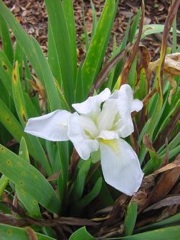
Every spring the Iris flower pokes it's majestic head out of innumerable garden settings. A favorite among gardeners for it's spectacular bloom, historically it was the root which was coveted by both perfumeries and apothecaries. Iris was named for the Greek goddess of the rainbow, and the image of the flower itself predates even the Greek civilization. It is seen in stone images as the famous Egyptian scepter, where the three petaled bloom represented faith, wisdom and valor. It may be recognized today as the French symbol of the fleur de lys.
Orris is a diuretic, which has been used to treat water retention, dropsy and edema. It has been used as an expectorant for centuries as well, treating chronic lung conditions and helping to expel phlegm. It is also a cathartic, and used to purge the bowels when a common laxative is not sufficient.
Today it is most valuable to the perfume industry, providing the deep violet scented base-note for many modern perfumes. Of course it's value to the modern gardener is indisputable, and has been throughout the ages.
Orris is a diuretic, which has been used to treat water retention, dropsy and edema. It has been used as an expectorant for centuries as well, treating chronic lung conditions and helping to expel phlegm. It is also a cathartic, and used to purge the bowels when a common laxative is not sufficient.
Today it is most valuable to the perfume industry, providing the deep violet scented base-note for many modern perfumes. Of course it's value to the modern gardener is indisputable, and has been throughout the ages.
Laurus nobilis
Bay Laurel
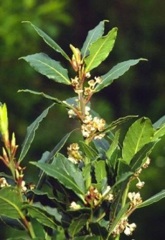
"Neither witch nor devil, thunder nor lightening, will hurt a man in the place where a Bay tree is."-Thomas Culpepper, 17th century.
The Bay tree is famous for it's use in ancient Rome, where garlands of it's leaves were used to crown athletes, poets and anyone deemed of outstanding measure. To this day the laurel represents fame for many, and the roots of this crowning tradition can be seen in words such as laureate and bachelor, bacca-laureus meaning laurel berries.
The origins of its ritual use go back to the oracle at Delphi, where the priestesses were said to have eaten a leaf before every prophesy. Laurel was a sacred plant of the god Appollo, and his temple was entirely thatched with its leaves, which were believed to prevent lightening, witchcraft and disease.
The leaves have been used to treat flatulence, hysteria and when taken in large quantities, they can be used as an emetic. An oil made from the leaves was applied to sprains, bruises and even poured into the ear for relief from earaches.
Of course the laurel is more commonly known as an ingredient to soups and stews, being a very common kitchen herb. Despite it's enduring popularity as a cooking spice, laurel is in fact considered inedible, and if the leaves are eaten in abundance they are actually quite narcotic.
The Bay tree is famous for it's use in ancient Rome, where garlands of it's leaves were used to crown athletes, poets and anyone deemed of outstanding measure. To this day the laurel represents fame for many, and the roots of this crowning tradition can be seen in words such as laureate and bachelor, bacca-laureus meaning laurel berries.
The origins of its ritual use go back to the oracle at Delphi, where the priestesses were said to have eaten a leaf before every prophesy. Laurel was a sacred plant of the god Appollo, and his temple was entirely thatched with its leaves, which were believed to prevent lightening, witchcraft and disease.
The leaves have been used to treat flatulence, hysteria and when taken in large quantities, they can be used as an emetic. An oil made from the leaves was applied to sprains, bruises and even poured into the ear for relief from earaches.
Of course the laurel is more commonly known as an ingredient to soups and stews, being a very common kitchen herb. Despite it's enduring popularity as a cooking spice, laurel is in fact considered inedible, and if the leaves are eaten in abundance they are actually quite narcotic.
Lavandula angustifolia
Lavender

The soothing effects of this scented plant are so incredible, it's said that even great beasts such as lions are calmed and made docile by the smell of lavender water. Certainly it's effectiveness as a home remedy for sleep and stress relief have been tested generation after generation.
The plant was given it's name from the Latin word 'lavare' meaning to wash or lather. It was a popular bathing herb in ancient Rome, being both aromatic, cleansing and also a natural insect repellent. It has highly antiseptic qualities as well, and the essential oil of lavender is still applied to cuts as an alternative to rubbing alcohol.
During the Medieval period, the herb was attributed with many mystical qualities, such as protection from evil and plague, the latter which is most certainly true to some degree. Great crosses of lavender were hung over church doors, it was strewn on floors for its beautiful scent and was carried as a general protection charm.
Today it not only remains a common home remedy for anxiety, insomnia and cuts, but is also used prolifically in the perfume and cosmetic industries, as well as being a favorite plant in any cottage garden.
The plant was given it's name from the Latin word 'lavare' meaning to wash or lather. It was a popular bathing herb in ancient Rome, being both aromatic, cleansing and also a natural insect repellent. It has highly antiseptic qualities as well, and the essential oil of lavender is still applied to cuts as an alternative to rubbing alcohol.
During the Medieval period, the herb was attributed with many mystical qualities, such as protection from evil and plague, the latter which is most certainly true to some degree. Great crosses of lavender were hung over church doors, it was strewn on floors for its beautiful scent and was carried as a general protection charm.
Today it not only remains a common home remedy for anxiety, insomnia and cuts, but is also used prolifically in the perfume and cosmetic industries, as well as being a favorite plant in any cottage garden.
Mandragora officinarum
Mandrake
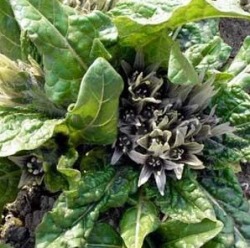
This plant has a truly magical history. Revered by the ancient Greeks as an aphrodisiac and a powerful intoxicant, it's use as a medicine and an amulet may have dated back to ancient Sumeria. It is mentioned several times in the Bible, both as a fertility charm when Rachel begs Leah for a piece of the root so that she may conceive, and as an herb sacred to Solomon.
During the Medieval period, it was prescribed by both the monks and the witches, and was used as everything from a cure for sterility to an ingredient in flying ointment.
There is inordinate superstition around the roots of these plants, which are long, rather gnarled and to some, resembled a human figure. The plants were said to scream as they were pulled from the earth, and later it was believed that each root housed a daemon. People were even to adopt the practice of using dogs as "sacrificial" animals, harnessing them to drag the roots out of the earth, for people understood that anyone to disrupt the mandrake root would themselves be cursed and possibly die.
Mandrakes were believed to grow under the gallows of murderers, and their apple scented fruit were referred to Satan's apples. There is an overwhelming amount of information suggesting abhorrence and fear of this plant, but despite this evidence, it was actually one of the most valuable herbs of this period, because it was believed to be a charm of good luck and fertility. A mandrake root kept on the mantle was supposed to guard a house, to promote prosperity and fertility and attract love into one's life. The roots became so valuable that merchants began to grow Byrony plants in moulds to imitate the contorted figures of mandrake roots, and these were sold for relatively large sums of money all over Europe.
The leaves of this plant can be applied as a poultice to any swelling, and the root is a powerful emetic. It was used as an anesthetic and added to wine in small amounts to treat chronic pain issues. It was also employed as a sedative, often in cases of mental delirium, although ironically it has historically been used to cause delirium and madness as well as treat it.
During the Medieval period, it was prescribed by both the monks and the witches, and was used as everything from a cure for sterility to an ingredient in flying ointment.
There is inordinate superstition around the roots of these plants, which are long, rather gnarled and to some, resembled a human figure. The plants were said to scream as they were pulled from the earth, and later it was believed that each root housed a daemon. People were even to adopt the practice of using dogs as "sacrificial" animals, harnessing them to drag the roots out of the earth, for people understood that anyone to disrupt the mandrake root would themselves be cursed and possibly die.
Mandrakes were believed to grow under the gallows of murderers, and their apple scented fruit were referred to Satan's apples. There is an overwhelming amount of information suggesting abhorrence and fear of this plant, but despite this evidence, it was actually one of the most valuable herbs of this period, because it was believed to be a charm of good luck and fertility. A mandrake root kept on the mantle was supposed to guard a house, to promote prosperity and fertility and attract love into one's life. The roots became so valuable that merchants began to grow Byrony plants in moulds to imitate the contorted figures of mandrake roots, and these were sold for relatively large sums of money all over Europe.
The leaves of this plant can be applied as a poultice to any swelling, and the root is a powerful emetic. It was used as an anesthetic and added to wine in small amounts to treat chronic pain issues. It was also employed as a sedative, often in cases of mental delirium, although ironically it has historically been used to cause delirium and madness as well as treat it.
Marrubium vulgare
Horehound
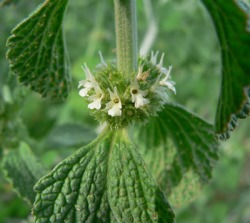
A close relative of the mint species, the plant is by far more bitter.
Perhaps the most common home remedy for coughs, Horehound has long been used to treat bronchial problems, tuberculosis and sore throats. It was considered to be a healing agent for any cold or flu and was used in cough drops and to flavor candies and beverages right into the late 1980's, when it was removed from the FDA list of approved herbs, under the pretense that there was not enough evidence to suggest it's medicinal qualities. Despite this it continues to be used by modern herbalists, and it has been employed for the same purposes since the ancient Egyptian civilization.
Egyptian priests named this plant 'Seed of Horus' although it's Latin name, Marrubium is derived from Maria urbs, an ancient town in Italy.
It is quite weedy in England, and apparently in Mexico as well, as the Spanish brought it over with them on the voyage to the New World.
Perhaps the most common home remedy for coughs, Horehound has long been used to treat bronchial problems, tuberculosis and sore throats. It was considered to be a healing agent for any cold or flu and was used in cough drops and to flavor candies and beverages right into the late 1980's, when it was removed from the FDA list of approved herbs, under the pretense that there was not enough evidence to suggest it's medicinal qualities. Despite this it continues to be used by modern herbalists, and it has been employed for the same purposes since the ancient Egyptian civilization.
Egyptian priests named this plant 'Seed of Horus' although it's Latin name, Marrubium is derived from Maria urbs, an ancient town in Italy.
It is quite weedy in England, and apparently in Mexico as well, as the Spanish brought it over with them on the voyage to the New World.
Melissa officinalis
Lemon Balm
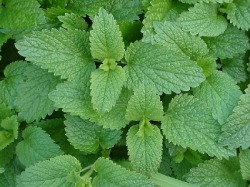
Balm is thought to have been introduced to most of Europe by the beginning of the ninth century, having been brought there by Arabian traders. It was however, prevalent in Greece centuries before where it was honored as the greatest of bee attractors, planted in quantity around hives and also revered as a great medicine and reliever of melancholy.
The first Holy Roman Emperor, Charlemagne was apparently so taken with it that he ordered it planted in all monastery gardens. Lemon Balm first appears in English herbal manuscripts in the early fourteen hundreds where it is referred to as bawme and recorded as having incredibly soothing and tonic properties.
Melissa in combination with lemon peel, angelica root, nutmeg and spirits made up the famous Carmelite water, which was desired for it's fresh smell and antiseptic qualities. In a time when the average person bathed once a year if not once a lifetime, potions such as this were necessary to quiet both the body's odors and the smell of death that surrounded the villages during times of plague.
Lemon balm is much used today for it's abilities to calm the nervous system, and especially to settle children. It is a lovely herb for the tea cup, being both aromatic and soothing.
The first Holy Roman Emperor, Charlemagne was apparently so taken with it that he ordered it planted in all monastery gardens. Lemon Balm first appears in English herbal manuscripts in the early fourteen hundreds where it is referred to as bawme and recorded as having incredibly soothing and tonic properties.
Melissa in combination with lemon peel, angelica root, nutmeg and spirits made up the famous Carmelite water, which was desired for it's fresh smell and antiseptic qualities. In a time when the average person bathed once a year if not once a lifetime, potions such as this were necessary to quiet both the body's odors and the smell of death that surrounded the villages during times of plague.
Lemon balm is much used today for it's abilities to calm the nervous system, and especially to settle children. It is a lovely herb for the tea cup, being both aromatic and soothing.
Mentha pulegium
Pennyroyal
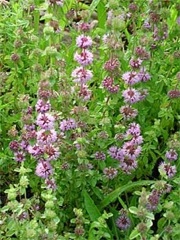
Pennyroyal has obtained a rather unfortunate reputation in the modern healing community, due both to its recurring use as an abortive and to the high toxicity levels that are present in the concentrated oil. It does however have an ancient history as a highly respected medicine. It's healing powers were thought to be so great that even dating to the Roman civilization, great wreaths of it were strung in doorways to purify the air.
It was recorded as a favorite among the English royal families, which may perhaps be attributed more to it's action as flea repellent than as a medicine. It has been noted as an insect repellent for centuries, it being said that Roman soldiers rubbed their bodies with it to offer protection from bugs and lice, and it is to this day one of the more effective ingredients in natural flea treatments for pets and animals.
It is the strongest of the mint family, and many of the attributes given to the mint family can be applied with pennyroyal in much smaller dosages. It is helpful for headaches and migraines, applied to the forehead or used as an inhalation. It is also excellent as a digestive aid when taken in small quantities.
It was recorded as a favorite among the English royal families, which may perhaps be attributed more to it's action as flea repellent than as a medicine. It has been noted as an insect repellent for centuries, it being said that Roman soldiers rubbed their bodies with it to offer protection from bugs and lice, and it is to this day one of the more effective ingredients in natural flea treatments for pets and animals.
It is the strongest of the mint family, and many of the attributes given to the mint family can be applied with pennyroyal in much smaller dosages. It is helpful for headaches and migraines, applied to the forehead or used as an inhalation. It is also excellent as a digestive aid when taken in small quantities.
Mentha spicata
Spearmint
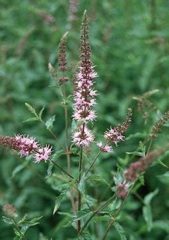
Perhaps the first plant mentioned in relation to Medieval herb gardens, Mint is of Mediterranean origin but was brought over to England as early as the eighth century by the Romans.
The name Mint comes to us from a Greek myth, in which Pluto was madly in love with a beautiful nymph named Minthe. Pluto's wife Prosperine was so enraged that she changed the nymph into the plant we now know as mint, where she continues to entice people to her with the extraordinary sweetness of her scent. The Greeks believed it could make a man so lustful that soldiers were warned to avoid it completely lest it drain all their energy before battle. Romans took quite a contrary view, and noting that it sharpened the mind and senses they encouraged scholars to wear wreaths of it when studying.
Of all medicinal garden herbs, surely one must recognize the mentha species as the most noteworthy of today's plants, being seen in everything from toothpaste and gum to a common tea. It's abilities to freshen the breath and settle the stomach are indisputable, and it's beneficial effects on headaches, digestion and nerves are also well known.
Despite their flavor and usefulness, one must be cautioned that when planting mint in the garden that it can grow very quickly and spread outrageously. Despite it's weedy tendencies, it is almost essential for an herb garden, but one plant perhaps to consider for container growing.
The name Mint comes to us from a Greek myth, in which Pluto was madly in love with a beautiful nymph named Minthe. Pluto's wife Prosperine was so enraged that she changed the nymph into the plant we now know as mint, where she continues to entice people to her with the extraordinary sweetness of her scent. The Greeks believed it could make a man so lustful that soldiers were warned to avoid it completely lest it drain all their energy before battle. Romans took quite a contrary view, and noting that it sharpened the mind and senses they encouraged scholars to wear wreaths of it when studying.
Of all medicinal garden herbs, surely one must recognize the mentha species as the most noteworthy of today's plants, being seen in everything from toothpaste and gum to a common tea. It's abilities to freshen the breath and settle the stomach are indisputable, and it's beneficial effects on headaches, digestion and nerves are also well known.
Despite their flavor and usefulness, one must be cautioned that when planting mint in the garden that it can grow very quickly and spread outrageously. Despite it's weedy tendencies, it is almost essential for an herb garden, but one plant perhaps to consider for container growing.
Menyanthes trifoliata
Buckbean
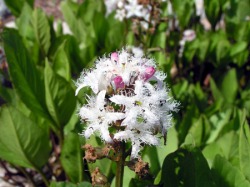
Commonly called Buckbean or Bogbean, this plant has gained much popularity as a flower for water gardens, due to it's stunning feathery pink flowers.
Still used in herbal medicine to this day, during the Medieval ages it was thought to be one of the strongest curatives available. A favorite remedy of monastery doctors, it was prescribed primarily for scurvy, but the seeds were also used for any respiratory complaints. It has been used to treat arthritis, jaundice, rheumatism, and was often taken as a general tonic.
Leaves of the buckbean were added to beers, it being a tremendously bitter plant, but much of the medicine was made from the rhizomes.
Today it is still used to treat fevers, constipation and water retention, although it is more available as a decorative bog plant than a medicine.
There is a curious old poem mentioning buckbean, which was said to be repeated when children walked through dark passages, and was apparently intended to be addressed to Puck or Robin Goodfellow.
"Buckee, Buckee, Biddy Bene,
Is the way now fair and clean?
Is the goose ygone to nest?
And the fox ygone to rest?
Shall I come away?"
Still used in herbal medicine to this day, during the Medieval ages it was thought to be one of the strongest curatives available. A favorite remedy of monastery doctors, it was prescribed primarily for scurvy, but the seeds were also used for any respiratory complaints. It has been used to treat arthritis, jaundice, rheumatism, and was often taken as a general tonic.
Leaves of the buckbean were added to beers, it being a tremendously bitter plant, but much of the medicine was made from the rhizomes.
Today it is still used to treat fevers, constipation and water retention, although it is more available as a decorative bog plant than a medicine.
There is a curious old poem mentioning buckbean, which was said to be repeated when children walked through dark passages, and was apparently intended to be addressed to Puck or Robin Goodfellow.
"Buckee, Buckee, Biddy Bene,
Is the way now fair and clean?
Is the goose ygone to nest?
And the fox ygone to rest?
Shall I come away?"
Myrrhis odorata
Sweet Cicely
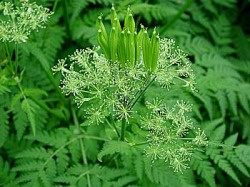
Sweet cicely, a native to Great Britain, is a beautiful fern-like plant with delicious licorice flavored seeds and foliage. The plant is actually so sweet that it can be cooked with tart and bitter fruits as an alternative to sugar to help cut down on the acidity.
The herb itself is considered very safe to use, the old herbalists saying it was "so harmless you cannot use it amiss."
It was a much used remedy for coughs and any intestinal complaints such as flatulence or weak stomachs, and is recommended as a lovely salad garnish which will also aid digestion and stimulate the appetite.
Cicely was commonly prescribed as a tonic for elderly people, it being thought to be a healthful and stimulating herb for them, as well as gentle enough for sensitive systems. Another old herb book describes it as being "Very good for old people that are dull and without courage; It rejoiceth and comforteth the heart and increaseth their lust and strength."
The herb itself is considered very safe to use, the old herbalists saying it was "so harmless you cannot use it amiss."
It was a much used remedy for coughs and any intestinal complaints such as flatulence or weak stomachs, and is recommended as a lovely salad garnish which will also aid digestion and stimulate the appetite.
Cicely was commonly prescribed as a tonic for elderly people, it being thought to be a healthful and stimulating herb for them, as well as gentle enough for sensitive systems. Another old herb book describes it as being "Very good for old people that are dull and without courage; It rejoiceth and comforteth the heart and increaseth their lust and strength."
Origanum majorana
Marjoram
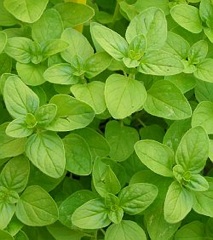
Although the word Marjoram may conjure no more for us these days than spice cabinets and spaghetti recipes, here is a plant that has long been associated with love and happiness. Legend tells that the plant was created by Aphrodite, as a symbol of love, and it was worn by bridal couples in both Greece and Rome. There is an also an old tradition of anointing oneself with Marjoram in order to see a vision of ones true love.
When Marjoram was found growing over a grave, it was thought to be the spirit of the deceased communicating their peace and happiness from the other side. Consequently, it became common practice to plant sweet Marjoram in cemeteries as a well-wishing for the departed.
Marjoram has an equally important history as a medicinal. In the Middle ages specifically it was worn with violets to protect against colds, chewed to relieve a toothache, used an inhalation to clear the sinuses, eaten as a digestive and applied as an antiseptic. A sweet water was made with Marjoram which was used to wash the body, thus protecting it from evil and, more practically, from disease.
This herb has also been extremely valuable in preserving food, and of course indisputably useful in flavoring food. Long before it's popularity in pasta dishes marjoram helped to keep the simple Medieval diet from being bland and unpalatable.
When Marjoram was found growing over a grave, it was thought to be the spirit of the deceased communicating their peace and happiness from the other side. Consequently, it became common practice to plant sweet Marjoram in cemeteries as a well-wishing for the departed.
Marjoram has an equally important history as a medicinal. In the Middle ages specifically it was worn with violets to protect against colds, chewed to relieve a toothache, used an inhalation to clear the sinuses, eaten as a digestive and applied as an antiseptic. A sweet water was made with Marjoram which was used to wash the body, thus protecting it from evil and, more practically, from disease.
This herb has also been extremely valuable in preserving food, and of course indisputably useful in flavoring food. Long before it's popularity in pasta dishes marjoram helped to keep the simple Medieval diet from being bland and unpalatable.
Origanum vulgare
Oregano
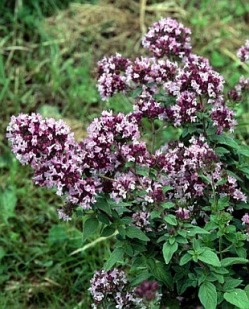
The name oregano is taken from two Greek words, oros and ganos, meaning mountain and joy, implying the great delight people took in it on the mountainsides of Greece.
During the Medieval period it was carried as a protection charm against witches, water sprites and beasts. Crushed leaves were often applied as a poultice to any bite, especially one which transmitted poison. It was actually burned as well, to purify the air and protect one from devils. It was used for the same culinary and medicinal purposes as marjoram the two being so closely related that they are almost indistinguishable in flavor and properties.
It's history is also quite inseparable from marjoram, and both were said to be gifts from Aphrodite to the world.
Everywhere this herb has traveled it has been locally adopted as a medicine. It traveled from Greece to Italy, and through the Roman armies to much of the rest of Europe, and when the trade routes were established, on to China where it was also taken as an excellent treatment for vomiting, skin irritation, diarrhea and fever.
Oil of Oregano is an important item on the shelves of any health food store or natural medicine practice, it being strongly antiviral and immune boosting. It is a natural remedy many still swear by to fight off colds and flues.
During the Medieval period it was carried as a protection charm against witches, water sprites and beasts. Crushed leaves were often applied as a poultice to any bite, especially one which transmitted poison. It was actually burned as well, to purify the air and protect one from devils. It was used for the same culinary and medicinal purposes as marjoram the two being so closely related that they are almost indistinguishable in flavor and properties.
It's history is also quite inseparable from marjoram, and both were said to be gifts from Aphrodite to the world.
Everywhere this herb has traveled it has been locally adopted as a medicine. It traveled from Greece to Italy, and through the Roman armies to much of the rest of Europe, and when the trade routes were established, on to China where it was also taken as an excellent treatment for vomiting, skin irritation, diarrhea and fever.
Oil of Oregano is an important item on the shelves of any health food store or natural medicine practice, it being strongly antiviral and immune boosting. It is a natural remedy many still swear by to fight off colds and flues.
Paris quadrifolia
Herb Paris
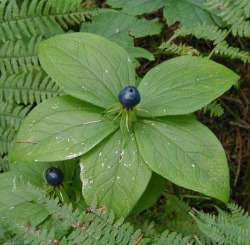
This delicate groundcover may also be referred to as Herb True Love, or True-lover's Knot.
A relative of Trillium, it is found in woodland settings, is native to cool parts of Europe and Asia, and is found only in the east of England.
No longer used in medicine at all due to the fact that it is highly poisonous, the root was once prescribed as a pain reliever for colic. Juice pressed from the leaves and seeds were applied to wounds, inflammations and tumors, and in very small doses it was once taken internally to ease bronchitis, spasmodic coughing, rheumatism and heart palpitations.
From the center of it's four perfect leaves it presents a single dark berry, which is extremely narcotic. Even a single berry may cause dizziness, nausea and an opium-like sedation. Apparently it was harvested for it's use as an aphrodisiac, and the plant has an ancient association with both sensuality and witchcraft.
A relative of Trillium, it is found in woodland settings, is native to cool parts of Europe and Asia, and is found only in the east of England.
No longer used in medicine at all due to the fact that it is highly poisonous, the root was once prescribed as a pain reliever for colic. Juice pressed from the leaves and seeds were applied to wounds, inflammations and tumors, and in very small doses it was once taken internally to ease bronchitis, spasmodic coughing, rheumatism and heart palpitations.
From the center of it's four perfect leaves it presents a single dark berry, which is extremely narcotic. Even a single berry may cause dizziness, nausea and an opium-like sedation. Apparently it was harvested for it's use as an aphrodisiac, and the plant has an ancient association with both sensuality and witchcraft.
Papaver somniferum
Poppy
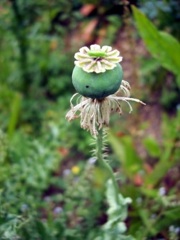
No flower could personify better both the demonization of medicine plants and the immense value of these plants to modern society. The opium poppy was found scattered in Neolithic grave sites and was attributed both healing and magical properties from Syria through to Egypt and Greece. It seems very likely that humans have cultivated a relationship with the poppy for simply as long as they have been humans, and as it has passed through cultures and civilizations, ritual and lore have sprouted alongside it.
Despite being the predominate painkiller on the planet and perhaps the most valued physicians drug throughout the ages, the poppy is intrinsically linked with darkness, seduction and witchcraft. It is often depicted as a sensuous and irresistible woman luring people to their deaths. The Greek deities Hypnos, Nyx and Thanatos (sleep, night and death) were all depicted as wearing wreaths of poppy flowers.
It was first cultivated as a drug during the Mesopotamian civilization in 3400 BC where it was called "the joy plant," and since then it's relationships with humanity as an intoxicant and a physicians medicine have been inseparable. Fearing to delve too much into the history of opium itself, I must assume most everyone is familiar with some of it's history, and it's relatively modern derivatives such as morphine, codeine and heroin.
Papaver was not cultivated (at least on an industrial level) in England for opium extraction until the seventeen hundreds. It was however used extensively as a pain reliever long before that, being introduced as early as the Roman occupation of Britain.
Laying aside it's history as a medicine, a pharmaceutical drug and a narcotic, the glorious poppy is still widely cultivated in home gardens for it's ornamental value, and it's notoriety has not caused gardeners to abandon it.
Despite being the predominate painkiller on the planet and perhaps the most valued physicians drug throughout the ages, the poppy is intrinsically linked with darkness, seduction and witchcraft. It is often depicted as a sensuous and irresistible woman luring people to their deaths. The Greek deities Hypnos, Nyx and Thanatos (sleep, night and death) were all depicted as wearing wreaths of poppy flowers.
It was first cultivated as a drug during the Mesopotamian civilization in 3400 BC where it was called "the joy plant," and since then it's relationships with humanity as an intoxicant and a physicians medicine have been inseparable. Fearing to delve too much into the history of opium itself, I must assume most everyone is familiar with some of it's history, and it's relatively modern derivatives such as morphine, codeine and heroin.
Papaver was not cultivated (at least on an industrial level) in England for opium extraction until the seventeen hundreds. It was however used extensively as a pain reliever long before that, being introduced as early as the Roman occupation of Britain.
Laying aside it's history as a medicine, a pharmaceutical drug and a narcotic, the glorious poppy is still widely cultivated in home gardens for it's ornamental value, and it's notoriety has not caused gardeners to abandon it.
Petasites hybridus
Butterbur
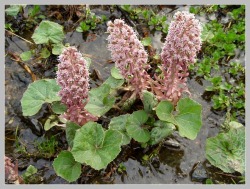
The name Butterbur was given to this plant because its enormous leaves were used to wrap butter during the hot weather. It was also known as Plague Flower, as it was reported to have successfully treated plague victims all through the 15th century.
Little is told of it's magical uses during this period, although apparently the seeds of this herb are used in love divination. The seeds were to be planted by an unwed girl, a half hour before sunrise on a Friday. She was supposed to repeat the charm "I sow, I sow, then my dear, come here come here, and mow, and mow!"
After the seeds were scattered she was expected to have a vision of her future husband standing with a scythe not far from her.
It has also been employed as both a heart stimulant and a treatment for asthma. The dried roots were the part of the plant normally used for medicine, and they were often dried, powdered and taken in wine.
Little is told of it's magical uses during this period, although apparently the seeds of this herb are used in love divination. The seeds were to be planted by an unwed girl, a half hour before sunrise on a Friday. She was supposed to repeat the charm "I sow, I sow, then my dear, come here come here, and mow, and mow!"
After the seeds were scattered she was expected to have a vision of her future husband standing with a scythe not far from her.
It has also been employed as both a heart stimulant and a treatment for asthma. The dried roots were the part of the plant normally used for medicine, and they were often dried, powdered and taken in wine.
Pimpinella anisum
Anise
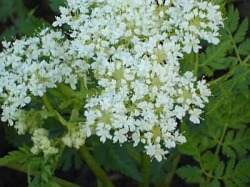
Several biblical references to anise suggest its long history as a food plant, and it has proved an invaluable spice, being adopted into such a profound diversity of cultures and cuisines.
Anise was considered an all-heal in the 14th century, and among other things it was used to treat snake and insect bites and was believed to be a powerful protector against the evil eye. As well as protection magic, this herb was incorporated into many handfasting ceremonies. It was considered to be both an aphrodisiac and a love charm. Perhaps it is not surprising that it has remained such a common ingredient in wedding cakes.
In 1305 it was declared a taxable drug, being so highly in demand, and the revenue these taxes earned helped Edward the 1st to repair London Bridge.
Now it is perhaps best known for it's flavorful contribution to many liquors such as Absinthe, Ouzo and Sambuca.
Anise was considered an all-heal in the 14th century, and among other things it was used to treat snake and insect bites and was believed to be a powerful protector against the evil eye. As well as protection magic, this herb was incorporated into many handfasting ceremonies. It was considered to be both an aphrodisiac and a love charm. Perhaps it is not surprising that it has remained such a common ingredient in wedding cakes.
In 1305 it was declared a taxable drug, being so highly in demand, and the revenue these taxes earned helped Edward the 1st to repair London Bridge.
Now it is perhaps best known for it's flavorful contribution to many liquors such as Absinthe, Ouzo and Sambuca.
Polygonatum commutatum
Solomon's Seal
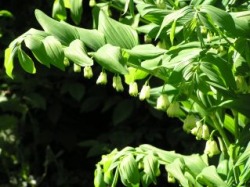
A beautiful woodland plant, Solomon's Seal is a close relative of Lily of the Valley, sharing with it a delicate white flower and an ability to grow in shady areas, making both a favorite in many garden settings. There are many varieties of Solomon's Seal, and there are several native species in North America, Northern Europe and Siberia.
Polygonatum is named for King Solomon, who legend tells us was an immensely knowledgeable herbalist, and well versed in the healing and magical properties of plants. The roots themselves bear interesting circular marks, which were believed to be the seal of Solomon's ring. It was also referred to as Lady's Seal and sometimes St. Mary's Seal.
It has been used to treat coughs and congestion, to help the mending of bones and to beautify the skin. In as early as 200 A.D. physicians suggested it could "cure" one from freckles. An interesting passage from Gerard, an herbalist of the 1500's states: "The roots of Solomon's Seal, stamped while it is fresh and greene and applied, taketh away in one night or two at the most, any bruise, blacke or blew spots gotten by fals or woman's wilfulness in stumbling apin their hastie husband's fists, or such like."
Polygonatum is named for King Solomon, who legend tells us was an immensely knowledgeable herbalist, and well versed in the healing and magical properties of plants. The roots themselves bear interesting circular marks, which were believed to be the seal of Solomon's ring. It was also referred to as Lady's Seal and sometimes St. Mary's Seal.
It has been used to treat coughs and congestion, to help the mending of bones and to beautify the skin. In as early as 200 A.D. physicians suggested it could "cure" one from freckles. An interesting passage from Gerard, an herbalist of the 1500's states: "The roots of Solomon's Seal, stamped while it is fresh and greene and applied, taketh away in one night or two at the most, any bruise, blacke or blew spots gotten by fals or woman's wilfulness in stumbling apin their hastie husband's fists, or such like."
Primula veris
Cowslip
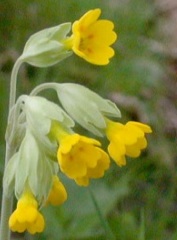
Cowslip, a type of yellow Primula, has had a variety of interesting names over the centuries, the most common of which are Keyflower, Our Lady's Keys and Keys to Heaven. It certainly lends itself to these names, as the flowers when picked are suggestive of a handful of keys, however it is supposed that the name comes from it's earlier history with the Norse goddess Freya, who the plant was dedicated to by the ancient Vikings. It was thought to be the key that admitted one to her palace.
Cowslip possesses mildly narcotic juices, giving one a pleasurable, mildly sedated feeling when ingested. Consequently it became very popular as a an additive to wine, and Cowslip wine is popular to this day in rural parts of England.
Apparently children made "Cowslip balls" as toys, and tying the stems together and tossing them around to each other in a circle as the ball fell to bits they would recite "Tissty-Tossty, Tell me true, Who am I going to be married to? Tinker, tailor, soldier, sailor, Rich man, poor man, beggar man, thief?" These balls could also be thrown over houses to try to chase away evil.
Primulas have had an excellent reputation for bettering the complexion, quieting the nerves and cheering the spirits.
Shakespeare refers to them in this passage: "I serve the Fairy Queen, To dew her orbs upon the green; The Cowslips tall her pensioners be; In their gold coats spots you see; Those be rubies fairy favours; In those freckles live their savours; I must go seek some dew drops here, and hang a pearl in every Cowslips ear."
Cowslip possesses mildly narcotic juices, giving one a pleasurable, mildly sedated feeling when ingested. Consequently it became very popular as a an additive to wine, and Cowslip wine is popular to this day in rural parts of England.
Apparently children made "Cowslip balls" as toys, and tying the stems together and tossing them around to each other in a circle as the ball fell to bits they would recite "Tissty-Tossty, Tell me true, Who am I going to be married to? Tinker, tailor, soldier, sailor, Rich man, poor man, beggar man, thief?" These balls could also be thrown over houses to try to chase away evil.
Primulas have had an excellent reputation for bettering the complexion, quieting the nerves and cheering the spirits.
Shakespeare refers to them in this passage: "I serve the Fairy Queen, To dew her orbs upon the green; The Cowslips tall her pensioners be; In their gold coats spots you see; Those be rubies fairy favours; In those freckles live their savours; I must go seek some dew drops here, and hang a pearl in every Cowslips ear."
Prunella vulgaris
Self-heal
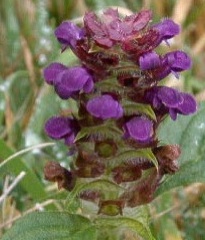
This low growing herb is also known as All-heal and Hercules's Woundwort. It was said that Hercules discovered the virtues of this plant from Chiron, a king among Centaurs who taught Hercules the physicians arts.
During the Medieval period, Prunella was still found abundantly in the wild places of Europe, making it a favorite of common people, soldiers and those who traveled without medical advisers. It was believed to be an excellent healer for wounds of all kinds, and is a perfectly safe plant to take internally, as the matter of fact the whole plant is edible and can also be picked as a salad green.
A juice or syrup was made from Self-heal for the treatment internal hemorrhaging and was often applied to the temples to sooth headaches. It was also taken as a tonic, and people credited it with immense value as a healing agent.
Because of it's small stature and the fact that it is quite indistinguishable until it's flowering time, one may have walked on, weeded out or failed to notice Self-heal. It grows easily and profusely where it is allowed, and is still found in the wild, but is rarely cultivated except by home herbalists.
Its reputation for easing bruises and burns, and being so accessible to the common folk, makes it quite comparable to plantain, which has more recently attained the same reputation.
During the Medieval period, Prunella was still found abundantly in the wild places of Europe, making it a favorite of common people, soldiers and those who traveled without medical advisers. It was believed to be an excellent healer for wounds of all kinds, and is a perfectly safe plant to take internally, as the matter of fact the whole plant is edible and can also be picked as a salad green.
A juice or syrup was made from Self-heal for the treatment internal hemorrhaging and was often applied to the temples to sooth headaches. It was also taken as a tonic, and people credited it with immense value as a healing agent.
Because of it's small stature and the fact that it is quite indistinguishable until it's flowering time, one may have walked on, weeded out or failed to notice Self-heal. It grows easily and profusely where it is allowed, and is still found in the wild, but is rarely cultivated except by home herbalists.
Its reputation for easing bruises and burns, and being so accessible to the common folk, makes it quite comparable to plantain, which has more recently attained the same reputation.
Rosa gallica
Apthacary's Rose
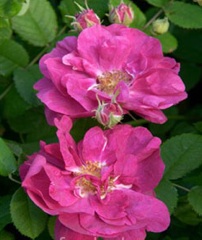
The stunning Rose has long been cultivated for its glorious bloom. It is believed to have originated around the area of the Caspian Sea, spreading across Mesopotamia to Palestine and eventually over to Greece. The Rose gallica was grown in profusion by the Greek and Roman peoples, and traveled to England with the Roman occupation.
It has long been seen as a symbol of love, but also of wealth and decadence with it's heady perfume and exotic blooms. Rose petals were scattered abundantly underfoot at festivals and celebrations to release its intoxicating aroma, and were woven into crowns and garlands. It was thought to be aphrodisiac, an invocation of the sensual self and a symbol of natures total perfection.
The cultivated Rose was strongly associated with pantheistic Rome, and was shunned in Western Europe through the Dark Ages, where it was seen as a flower of lust, bewitchment and Paganism. The Arthurian legends reflect the early attitude towards roses, one story picturing Merlin being trapped by a Sorceress with rose flowers. The ancient Fairytale of Sleeping Beauty who was trapped under an enchantment behind a wall of roses that none could pass also exemplifies this stigma around roses.
They did not gain acceptance in Western Europe until they were adopted by the Catholic Church to symbolize the Virgin Mary. They gradually began to be pictured as a flower of motherhood, purity and spirituality. By the Medieval period they were a beloved flower in every monastery, and were used a medicine, a decoration and a perfume. Rose hips are an excellent source of vitamins, and Water of Roses was taken by many as a cordial, and drank to strengthen weak stomachs and constitutions, as well as to help the heart.
Perhaps a revealing glimpse into our ancestry, the Rose remains a symbol of love and the heart to this day.
It has long been seen as a symbol of love, but also of wealth and decadence with it's heady perfume and exotic blooms. Rose petals were scattered abundantly underfoot at festivals and celebrations to release its intoxicating aroma, and were woven into crowns and garlands. It was thought to be aphrodisiac, an invocation of the sensual self and a symbol of natures total perfection.
The cultivated Rose was strongly associated with pantheistic Rome, and was shunned in Western Europe through the Dark Ages, where it was seen as a flower of lust, bewitchment and Paganism. The Arthurian legends reflect the early attitude towards roses, one story picturing Merlin being trapped by a Sorceress with rose flowers. The ancient Fairytale of Sleeping Beauty who was trapped under an enchantment behind a wall of roses that none could pass also exemplifies this stigma around roses.
They did not gain acceptance in Western Europe until they were adopted by the Catholic Church to symbolize the Virgin Mary. They gradually began to be pictured as a flower of motherhood, purity and spirituality. By the Medieval period they were a beloved flower in every monastery, and were used a medicine, a decoration and a perfume. Rose hips are an excellent source of vitamins, and Water of Roses was taken by many as a cordial, and drank to strengthen weak stomachs and constitutions, as well as to help the heart.
Perhaps a revealing glimpse into our ancestry, the Rose remains a symbol of love and the heart to this day.
Rosmarinus officinalis
Rosemary

This aromatic evergreen shrub is much esteemed for it's fragrance, beauty and culinary uses. Here is a truly helpful herb; one that can be used to clean the house with it's disinfecting oil, bring out the flavor in a roast or, according to the ancients, chase evil spirits from your home.
Traditionally, Rosemary was held to be a great healer of the mind and specifically memory. It was employed by ancient Greek physicians as a memory aid, and this may have forged it's association with loyalty, fidelity and love. Garlands of Rosemary were given to brides, and sprigs were also handed out to mourners. It is the only herb that was given at both weddings and funerals. Newlyweds were encouraged to plant a Rosemary bush at the entrance of their home, and if the plant flourished it was thought to be a good omen for the marriage. A plant at ones door, or perhaps a wreath hung above the threshold was also thought to protect the home and keep restless spirits from entering.
Rosemary has a long history as an incense and was used in the purification of temples and sickrooms alike. It is very astringent and useful as an antibacterial as well.
There is an old proverb, "Where Rosemary flourishes, women rule." The health of the herb was thought to demonstrate the power of the woman of the household. There are apparently cases of men injuring their Rosemary bushes so as not to appear dominated by their wives.
Rosemary was used in rituals of love, purification, protection, friendship and mourning.
Traditionally, Rosemary was held to be a great healer of the mind and specifically memory. It was employed by ancient Greek physicians as a memory aid, and this may have forged it's association with loyalty, fidelity and love. Garlands of Rosemary were given to brides, and sprigs were also handed out to mourners. It is the only herb that was given at both weddings and funerals. Newlyweds were encouraged to plant a Rosemary bush at the entrance of their home, and if the plant flourished it was thought to be a good omen for the marriage. A plant at ones door, or perhaps a wreath hung above the threshold was also thought to protect the home and keep restless spirits from entering.
Rosemary has a long history as an incense and was used in the purification of temples and sickrooms alike. It is very astringent and useful as an antibacterial as well.
There is an old proverb, "Where Rosemary flourishes, women rule." The health of the herb was thought to demonstrate the power of the woman of the household. There are apparently cases of men injuring their Rosemary bushes so as not to appear dominated by their wives.
Rosemary was used in rituals of love, purification, protection, friendship and mourning.
Rumex acetosa
Sorrel
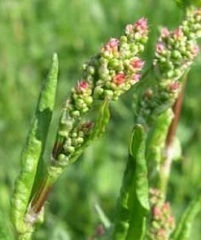
The name Sorrel is derived from an old Germanic word, sur, and also from the French surele, both meaning sour. The plant has a sharply acidic flavor which many delight in, and the plant was noted in recipes dating to the early Egyptian civilization. It was an immensely common garden herb in Europe, and was very much used as a salad green and a pottage herb. Sorrel leaves are extremely high in vitamin c, and it is a worthy plant to combat scurvy and many vitamin deficiencies.
Very popular during the reign of Henry the VII, Sorrel was shorty to be supplanted by French Sorrel, which is essentially the same but with a much larger and more succulent leaf. Sorrel is an esteemed herb in France, being used in many soups and dishes. During the Medieval period it was often ground fresh with a small amount of vinegar and used as a meat sauce. Greensauce is an old name for Sorrel.
Medicinally, Sorrel was thought to be a cooling herb, soothing inflammations of both the body and temper and was highly recommended to ease someone out of a violent state. It was used to stimulate the appetite and the digestive fluids.
Still a much seen garden perennial, Sorrel is an early Spring green, and has quite a mild flavor in it's early months. As the Summer progresses the leaves become quite bitter and sour, but to some this is when it is most prized for eating.
Very popular during the reign of Henry the VII, Sorrel was shorty to be supplanted by French Sorrel, which is essentially the same but with a much larger and more succulent leaf. Sorrel is an esteemed herb in France, being used in many soups and dishes. During the Medieval period it was often ground fresh with a small amount of vinegar and used as a meat sauce. Greensauce is an old name for Sorrel.
Medicinally, Sorrel was thought to be a cooling herb, soothing inflammations of both the body and temper and was highly recommended to ease someone out of a violent state. It was used to stimulate the appetite and the digestive fluids.
Still a much seen garden perennial, Sorrel is an early Spring green, and has quite a mild flavor in it's early months. As the Summer progresses the leaves become quite bitter and sour, but to some this is when it is most prized for eating.
Ruta graveolens
Rue
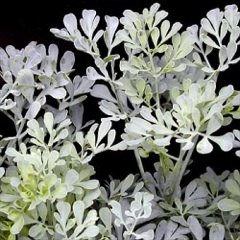
From Pliny to Shakespeare, Rue has been noted by countless physicians and poets alike throughout the ages. Although the etymology of the word remains unknown, it's exact likeness to the English word rue, implying grief, bitterness and regret, has perhaps cast a shadow over its history. Being the most bitter of herbs, and also an evergreen, a sprig of rue was sometimes used to represent a deep and lasting grief. Jilted girls were said to throw it at unfaithful lovers imparting the curse "May you rue this day until you die!"
Despite the misfortune of it's name, Rue was a most celebrated physicians herb, and much adopted by the monasteries. It was used in Holy Water, hung about homes and chapels for protection against witchcraft, and given many names that reflected its spiritual significance, such as Herb of Grace, Blessed Herb and Herb of Repentance. It certainly earned its reputation during times of plague, as it was the most effective of all flea repellents available during the period, and floors and flesh were smeared with its juice to chase away disease carrying pests. It was one of the ingredients in the Four Thieves Vinegar, the others apparently being Lavender, Thyme, Sage, Rosemary, Garlic, Mint and Wormwood.
Whilst being beloved as a bitter, Rue was also said to improve eyesight, and Michelangelo and De Vinci were both said to have eaten it's leaves regularly.
Rue is a very attractive evergreen herb with silvery foliage and delicate club shaped leaves. The Rue leaf has been immortalized in playing cards, the club suit being pictured after it.
Despite the misfortune of it's name, Rue was a most celebrated physicians herb, and much adopted by the monasteries. It was used in Holy Water, hung about homes and chapels for protection against witchcraft, and given many names that reflected its spiritual significance, such as Herb of Grace, Blessed Herb and Herb of Repentance. It certainly earned its reputation during times of plague, as it was the most effective of all flea repellents available during the period, and floors and flesh were smeared with its juice to chase away disease carrying pests. It was one of the ingredients in the Four Thieves Vinegar, the others apparently being Lavender, Thyme, Sage, Rosemary, Garlic, Mint and Wormwood.
Whilst being beloved as a bitter, Rue was also said to improve eyesight, and Michelangelo and De Vinci were both said to have eaten it's leaves regularly.
Rue is a very attractive evergreen herb with silvery foliage and delicate club shaped leaves. The Rue leaf has been immortalized in playing cards, the club suit being pictured after it.
Salvia officinalis
Sage

Cur moriatur homo cui Salvia crescit in horto?
Why should a man die whilst Sage grows in his garden?
Sage is yet another of the Mediterranean plants that was adopted by Western Europe and has become in irreplaceable kitchen herb. The health benefits of Sage have been well known for centuries, and the name Salvia comes from the Latin salvare, to be saved. Sage was thought invaluable as a tonic, and being a tasty herb for cooking and a fine tea substitute as well, it was recommended and enjoyed for daily use.
Sage was often employed as a gargle, being very soothing for a sore throat, but it has been ascribed a wide variety of uses, being said to stay the bleeding of wounds, clean an ulcer, and help ease pains of the head and joints. It was prescribed to women with difficult courses, and sometimes used during dangerous childbirths.
During the Middle Ages physicians used the plant to treat memory loss, and the ancient Greeks and Romans also revered the plant as a great mental stimulant and bringer of clarity. The Romans believed the plant belonged to the Satyrs, creatures who were half man and half goat, and some Roman physicians even promoted Sage as herb which could impart immortality.
Sage is such a regular sight in herb gardens that one could almost go so far as to say none is complete without it. It has a beautiful silvery color, and will often keep its leaves through the winter. Throughout history some have said that this is an indication of one's success, and that if one plants Sage outside a home or business, its reaction to Winter foretells how they themselves will weather the season.
Why should a man die whilst Sage grows in his garden?
Sage is yet another of the Mediterranean plants that was adopted by Western Europe and has become in irreplaceable kitchen herb. The health benefits of Sage have been well known for centuries, and the name Salvia comes from the Latin salvare, to be saved. Sage was thought invaluable as a tonic, and being a tasty herb for cooking and a fine tea substitute as well, it was recommended and enjoyed for daily use.
Sage was often employed as a gargle, being very soothing for a sore throat, but it has been ascribed a wide variety of uses, being said to stay the bleeding of wounds, clean an ulcer, and help ease pains of the head and joints. It was prescribed to women with difficult courses, and sometimes used during dangerous childbirths.
During the Middle Ages physicians used the plant to treat memory loss, and the ancient Greeks and Romans also revered the plant as a great mental stimulant and bringer of clarity. The Romans believed the plant belonged to the Satyrs, creatures who were half man and half goat, and some Roman physicians even promoted Sage as herb which could impart immortality.
Sage is such a regular sight in herb gardens that one could almost go so far as to say none is complete without it. It has a beautiful silvery color, and will often keep its leaves through the winter. Throughout history some have said that this is an indication of one's success, and that if one plants Sage outside a home or business, its reaction to Winter foretells how they themselves will weather the season.
Sempervivum
Houseleek

This beautiful succulent is now almost exclusively called Hens and Chicks, but more ancient names for it include Thor's Beard, Thunderbeard and Jupiter's Eye. The plant was dedicated to Jupiter of old, a God associated with thunder, and the history of the Houseleek itself is interwoven with tales of weather magic and superstition. It was planted at the door of Roman houses, and was said to protect the home, especially from the elements and storms. Charlemagne apparently ordered the roof of every house to be planted with it with this reason in mind. In many parts of Europe it can still be found on the roofs of cottages. It was also thought to guard against sorcery.
The Latin Sempervivum comes from the words semper, meaning always and vive, meaning to live. This is a plant that is well suited for rock gardens, growing and multiplying profusely with little or no soil and seems to endure a remarkably long time without pampering of any kind.
The thick juicy leaves of the Houseleek can be sliced open and applied to any burn or sore in the same way that Aloe Vera is used today, with similar effects. It is also an effective treatment of warts.
The Latin Sempervivum comes from the words semper, meaning always and vive, meaning to live. This is a plant that is well suited for rock gardens, growing and multiplying profusely with little or no soil and seems to endure a remarkably long time without pampering of any kind.
The thick juicy leaves of the Houseleek can be sliced open and applied to any burn or sore in the same way that Aloe Vera is used today, with similar effects. It is also an effective treatment of warts.
Symphytum officinale
Comfrey
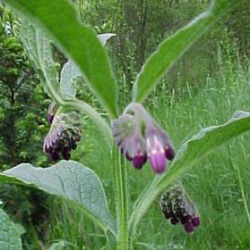
During the Middle Ages Comfrey was thought to be the primary cure for broken bones. The word Comfrey itself is a corruption of the Latin con firma, meaning 'to grow together' alluding to the uniting of bones.
The roots of comfrey were taken in wine to ease any internal bleeding and complaints of the lungs. The plant is tremendously expectorant. The roots and leaved could be pulverized and applied to any outward cut, swelling or injury. Comfrey root is still used topically, in similar fashion to Arnica to hurry the healing of bruises and wounds.
Chicory, Dandelion and Comfrey roots are all used make a coffee substitute, and although it has been disputed in our century, Comfrey has always been seen as a harmless and beneficial herb to take internally, although the leaves are course and hairy once they reach maturity.
Comfrey was recorded as being given to bards and minstrels as a protection amulet in their travels, although it may also have been similar to a Medieval first aid kit, being the most esteemed remedy of the times for physical accident or injury.
Comfrey is an excellent garden plant owing to the nutrients found in its leaves. In modern organic farming it is often planted next to a compost, and added to it regular to produce rich and healthy soil. Salves made from its root are still considered an effective aid in the mending of bones and healing of bruises.
The roots of comfrey were taken in wine to ease any internal bleeding and complaints of the lungs. The plant is tremendously expectorant. The roots and leaved could be pulverized and applied to any outward cut, swelling or injury. Comfrey root is still used topically, in similar fashion to Arnica to hurry the healing of bruises and wounds.
Chicory, Dandelion and Comfrey roots are all used make a coffee substitute, and although it has been disputed in our century, Comfrey has always been seen as a harmless and beneficial herb to take internally, although the leaves are course and hairy once they reach maturity.
Comfrey was recorded as being given to bards and minstrels as a protection amulet in their travels, although it may also have been similar to a Medieval first aid kit, being the most esteemed remedy of the times for physical accident or injury.
Comfrey is an excellent garden plant owing to the nutrients found in its leaves. In modern organic farming it is often planted next to a compost, and added to it regular to produce rich and healthy soil. Salves made from its root are still considered an effective aid in the mending of bones and healing of bruises.
Tanacetum parthenium
Feverfew
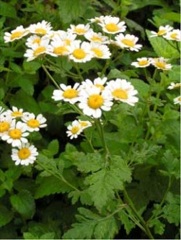
Similar in appearance to Chamomile, Feverfew is almost as common in the home garden, often unintentionally for once planted it can become quite weedy. However, it is a truly valued medicinal plant, and its petite daisy-like flowers are always a cheering sight.
Feverfew, as it's name suggests was used in the treatment of fevers, and migraines headaches as well. There was a practice of binding Feverfew around ones wrists to draw out pain, and it was sometimes worn or sprigs of it carried to ward off illness. One of its famous applications in Medieval Europe was in its planting, for it was grown profusely around homes to ward off plague and disease.
Parthenium, its botanical name is taken from the Greek word for girl, as it was used as a woman's medicine in Greek, as well as the treatment of inflammation and headaches. Interestingly, it was also used in ancient Greece to treat melancholy and depression, which was a a practice continued by the English into the seventeen hundreds.
As a home remedy for headaches, Feverfew is still considered very effective. A small amount of the leaf is chewed when the first symptoms are noticed.
Feverfew, as it's name suggests was used in the treatment of fevers, and migraines headaches as well. There was a practice of binding Feverfew around ones wrists to draw out pain, and it was sometimes worn or sprigs of it carried to ward off illness. One of its famous applications in Medieval Europe was in its planting, for it was grown profusely around homes to ward off plague and disease.
Parthenium, its botanical name is taken from the Greek word for girl, as it was used as a woman's medicine in Greek, as well as the treatment of inflammation and headaches. Interestingly, it was also used in ancient Greece to treat melancholy and depression, which was a a practice continued by the English into the seventeen hundreds.
As a home remedy for headaches, Feverfew is still considered very effective. A small amount of the leaf is chewed when the first symptoms are noticed.
Tanacetum vulgare
Tansy
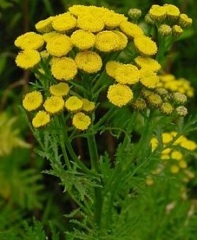
Also known as Golden Buttons, Tansy was originally named for the Greek word athanaton, meaning immortal. Legend tells us that it was given to Ganymede, a prince of Troy who Zeus singled out for his beauty, to make him immortal. The name may also refer to the outstandingly long lasting flowers, or the fact that it was thought an excellent embalming herb due to the clean potent smell of the crushed leaves. It was the herb most commonly packed into coffins and winding sheets, and is somewhat associated with mourning. It was also quite popular as a strewing herb because it repelled so effectively fleas and other insects from the home.
References of Tansy as a food plant are quite ancient, and in Medieval Europe it became associated with the Easter festival and the end of Lent. There was often jousting and games, the rewards of which were Tansy cakes, and the flavor of the leaves was said to recall the bitterness of the traditional Passover greens.
There was an interesting belief that nibbling the feathery leaves would help couples to conceive, which was apparently based on the fact that rabbits, (such prolific breeders) nibbled at it regularly. This is particularly curious because Tansy is such a strong abortive, and its power to bring on a woman's courses are widely known; the practice of Tansy induced miscarriages was common all through Europe.
A close relative of Feverfew, Tansy was also used to treat fevers, colds and jaundice. Sometimes a bath was taken in water steeped with the herb to ease pain in ones joints.
References of Tansy as a food plant are quite ancient, and in Medieval Europe it became associated with the Easter festival and the end of Lent. There was often jousting and games, the rewards of which were Tansy cakes, and the flavor of the leaves was said to recall the bitterness of the traditional Passover greens.
There was an interesting belief that nibbling the feathery leaves would help couples to conceive, which was apparently based on the fact that rabbits, (such prolific breeders) nibbled at it regularly. This is particularly curious because Tansy is such a strong abortive, and its power to bring on a woman's courses are widely known; the practice of Tansy induced miscarriages was common all through Europe.
A close relative of Feverfew, Tansy was also used to treat fevers, colds and jaundice. Sometimes a bath was taken in water steeped with the herb to ease pain in ones joints.
Thymus vulgaris
Thyme
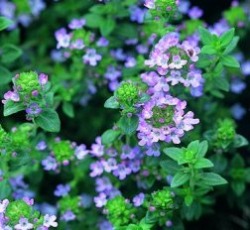
Thyme received it's name from the Greek word thumos, meaning to smoke, strongly suggesting it as a favorite of the temples, where fragrant herbs were burned in profusion to cleanse and sanctify the spaces. To the Greeks, Thyme also represented bravery, and centuries later during the 1400's, ladies were to embroider sprays of Thyme on scarves to give their suitors in the jousts.
It was much planted in Rome because it was so excellent as a bee plant, and was said to be a symbol of style and grace. To "smell of Thyme" was a form of praise, meaning one had a sense of style.
In the Dark Ages the plant came to represent love, being used in many charms for love and divination. On St. Agnes Eve the herbs were presented with the verse "St. Agnes that's to lovers kind, Come ease the troubles of my mind." On St. Luke's day tradition held that young maids should make a potion from Thyme, Marigolds, Wormwood, Marjoram and honey, then anointing their lips and stomachs, lie down and repeat "St. Luke, St. Luke be kind to me, In dream let me my true love see."
Hills of wild Thyme were thought to be the nesting places of faeries, and ungents made from the herbs of these hills were taken to help one see the little folk.
Thyme was anciently used to treat consumption, nightmares, fatigue, whooping cough and spasms, although oddly was not used as a culinary spice until much later.
It was much planted in Rome because it was so excellent as a bee plant, and was said to be a symbol of style and grace. To "smell of Thyme" was a form of praise, meaning one had a sense of style.
In the Dark Ages the plant came to represent love, being used in many charms for love and divination. On St. Agnes Eve the herbs were presented with the verse "St. Agnes that's to lovers kind, Come ease the troubles of my mind." On St. Luke's day tradition held that young maids should make a potion from Thyme, Marigolds, Wormwood, Marjoram and honey, then anointing their lips and stomachs, lie down and repeat "St. Luke, St. Luke be kind to me, In dream let me my true love see."
Hills of wild Thyme were thought to be the nesting places of faeries, and ungents made from the herbs of these hills were taken to help one see the little folk.
Thyme was anciently used to treat consumption, nightmares, fatigue, whooping cough and spasms, although oddly was not used as a culinary spice until much later.
Valeriana officinalis
Valerian
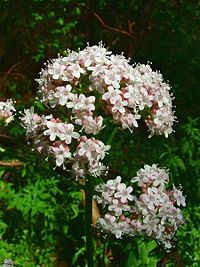
Anyone who has suffered from insomnia or stress will likely be familiar with the healing properties of Valerian root. It is, and has been since ancient times, the most prescribed natural sleep medicine, and can also be helpful as a nerve tonic for those dealing with anxiety.
Its name is derived from valare, the Latin for health, and the plant appears in historical texts as a physicians plant in as early as 460 B.C. It seems that it was often used to treat urinary tract and bladder infections, perhaps before its relevance as a sedative became apparent. Its soothing properties were inevitably noted, as Valerian was quite popular as a food plant, being used in all kinds of sauces, salads and stews. It appears in a dinner recipe from the 1500's to "stop men from quarreling," and there is no doubt the quieting effects of this herb were observed.
It may seem very unusual to people of today that this plant was so popular as a spice, given that its aroma has a rather unfortunate reputation. Students of herbal medicine are often warned before handling the plant that "smells like old socks."
Valerian is noted as appearing in many love spells, the most unique of which was a draught to reunite fighting lovers. No doubt a powerful sedative is appreciated to cool the tempers of some couples. When planted around the house it was thought to bring peace and tranquility to ones home, and for those interested in pursuing this tradition, slightly less fragrant varieties are now available. I have personally never been bothered by the smell of Valerian, and was not surprised to learn that it appears as the base note in many early perfumes, some dating back to ancient Egypt.
Its name is derived from valare, the Latin for health, and the plant appears in historical texts as a physicians plant in as early as 460 B.C. It seems that it was often used to treat urinary tract and bladder infections, perhaps before its relevance as a sedative became apparent. Its soothing properties were inevitably noted, as Valerian was quite popular as a food plant, being used in all kinds of sauces, salads and stews. It appears in a dinner recipe from the 1500's to "stop men from quarreling," and there is no doubt the quieting effects of this herb were observed.
It may seem very unusual to people of today that this plant was so popular as a spice, given that its aroma has a rather unfortunate reputation. Students of herbal medicine are often warned before handling the plant that "smells like old socks."
Valerian is noted as appearing in many love spells, the most unique of which was a draught to reunite fighting lovers. No doubt a powerful sedative is appreciated to cool the tempers of some couples. When planted around the house it was thought to bring peace and tranquility to ones home, and for those interested in pursuing this tradition, slightly less fragrant varieties are now available. I have personally never been bothered by the smell of Valerian, and was not surprised to learn that it appears as the base note in many early perfumes, some dating back to ancient Egypt.
Verbena officinalis
Vervain
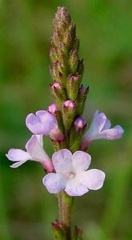
The name Vervain is from the Celtic words fer and faen, meaning to drive away and stone, which refers to the plants use in the treatment of kidney stones. The plant was also called Herba Sacra, meaning an alter herb, as it was burned by the Greeks and Romans during sacrifices and rituals. The tiny flowers were thought to be a powerful aphrodisiac, and the Romans dedicated this herb to Isis and to Venus, the planet of love and sensuality.
It seems many cultures have employed Vervain for magical purposes; it was a most sacred plant to the druids, and among other things they used it to make a sort of holy water. Vervain was used for spells of love and protection, and the practice of making it into a water appears in many traditions. In some writings, even rinsing ones hands in this water was said to cause those one touches to fall in love with them. The tiniest sprig pinned to the hem of a woman's dress was thought to attract suitors. It is still used today in the North American practice of Hoodoo, where they simmer in oil and make the famous Van-Van oil, which is worn for protection.
To some this plant is known as Herb of the Cross, as myth tells that it was discovered upon the Mound of Calvary and used to staunch the blood from Jesus' wounds.
Whenever it was discovered, it is most certainly a common plant, growing wild in many parts of Europe and North America. Despite its abundance, there remains a mystique around the herb, and it is often wildcrafted as a home remedy for colds and fevers and, quite possibly, the occasional love spell.
It seems many cultures have employed Vervain for magical purposes; it was a most sacred plant to the druids, and among other things they used it to make a sort of holy water. Vervain was used for spells of love and protection, and the practice of making it into a water appears in many traditions. In some writings, even rinsing ones hands in this water was said to cause those one touches to fall in love with them. The tiniest sprig pinned to the hem of a woman's dress was thought to attract suitors. It is still used today in the North American practice of Hoodoo, where they simmer in oil and make the famous Van-Van oil, which is worn for protection.
To some this plant is known as Herb of the Cross, as myth tells that it was discovered upon the Mound of Calvary and used to staunch the blood from Jesus' wounds.
Whenever it was discovered, it is most certainly a common plant, growing wild in many parts of Europe and North America. Despite its abundance, there remains a mystique around the herb, and it is often wildcrafted as a home remedy for colds and fevers and, quite possibly, the occasional love spell.
Viola odorata
Violet
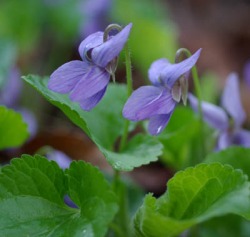
This sweet little woodland flower is now available in a seemingly infinite variety of forms and colors, but in all cases the blooms are both charming and tasty. Its name comes from the Greek name Ione, and there is of course a myth pertaining to it. The God Jupiter fell madly in love with a mortal woman (Ione) and fearing the jealousy of Juno, he changed her into a white heifer. He was so besotted that he created the lovely violet plant for her to feed upon.
It would seem humans have always been attracted to this delicate flower, and it has been ascribed with a bewildering amount of medical and magical attributes. In Greece Violets were used to strengthen the heart, induce sleep and garlands of violets were thought to ward off drunkenness and clear the mind. The Celts soaked the blossoms in Goats milk and the result was a wash which was said to make any woman beautiful. By the tenth century it was being used to protect oneself from evil spirits, and was appearing in recipes for sweets, syrups, wines and medicines.
Violets, like Rosemary, are associated through folklore with both love and death, and specifically with the death of children. Mixed with Lavender, they were thought to attract ones true love. In the subtle language born from flower arranging that became so popular in the Victorian era, Violets were used to represent faithfulness and modesty.
Syrup of Violets was noted on the apothecary shelves in the 1500's and was used as a mild laxitive, and to sooth headaches, insomnia and bronchial afflictions.
There is an old belief that if one can pick the first violet of Spring, any wish made will be granted.
It would seem humans have always been attracted to this delicate flower, and it has been ascribed with a bewildering amount of medical and magical attributes. In Greece Violets were used to strengthen the heart, induce sleep and garlands of violets were thought to ward off drunkenness and clear the mind. The Celts soaked the blossoms in Goats milk and the result was a wash which was said to make any woman beautiful. By the tenth century it was being used to protect oneself from evil spirits, and was appearing in recipes for sweets, syrups, wines and medicines.
Violets, like Rosemary, are associated through folklore with both love and death, and specifically with the death of children. Mixed with Lavender, they were thought to attract ones true love. In the subtle language born from flower arranging that became so popular in the Victorian era, Violets were used to represent faithfulness and modesty.
Syrup of Violets was noted on the apothecary shelves in the 1500's and was used as a mild laxitive, and to sooth headaches, insomnia and bronchial afflictions.
There is an old belief that if one can pick the first violet of Spring, any wish made will be granted.
Vitex agnus-castus
Chaste Tree
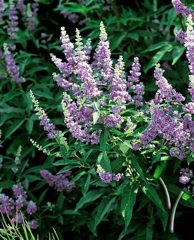
In this beautiful branching shrub, not unlike a Lilac in appearance, we find one of the original woman's medicines. From the time of Hippocrates we find testaments to this herb as a treatment for many different menstrual disorders and hormonal conditions.
In the Greek festival of Thesmorphia, women would adorn their heads with branches from the Vitex tree and boughs and blossoms were strewn all about the temples of Demetre. As its name suggests, the plant is anciently associated with chastity, which is not surprising as the flowers are an anaphrodisiac, and known to quell the male libido. Athenian woman, and matrons of Rome as well were known to scatter flowers all about their couches to help them remain pure, or at least to suggest their purity to the guests.
With its reputation for inspiring chastity it is not surprising that it was so readily adopted by the Medieval monasteries, and the ritual to have a fresh novitiate enter the chapel through a path strewn with Vitex flowers still remains to this day in parts of Italy.
Aside from helping the monks to keep their minds on the scriptures, the seeds of this plant were also used as deliciously spicy substitute for black pepper.
Now marketed as Chasteberry, the plant has undergone several clinical studies and is still commonly prescribed as a treatment for P.M.S. and hormonal imbalances.
In the Greek festival of Thesmorphia, women would adorn their heads with branches from the Vitex tree and boughs and blossoms were strewn all about the temples of Demetre. As its name suggests, the plant is anciently associated with chastity, which is not surprising as the flowers are an anaphrodisiac, and known to quell the male libido. Athenian woman, and matrons of Rome as well were known to scatter flowers all about their couches to help them remain pure, or at least to suggest their purity to the guests.
With its reputation for inspiring chastity it is not surprising that it was so readily adopted by the Medieval monasteries, and the ritual to have a fresh novitiate enter the chapel through a path strewn with Vitex flowers still remains to this day in parts of Italy.
Aside from helping the monks to keep their minds on the scriptures, the seeds of this plant were also used as deliciously spicy substitute for black pepper.
Now marketed as Chasteberry, the plant has undergone several clinical studies and is still commonly prescribed as a treatment for P.M.S. and hormonal imbalances.
